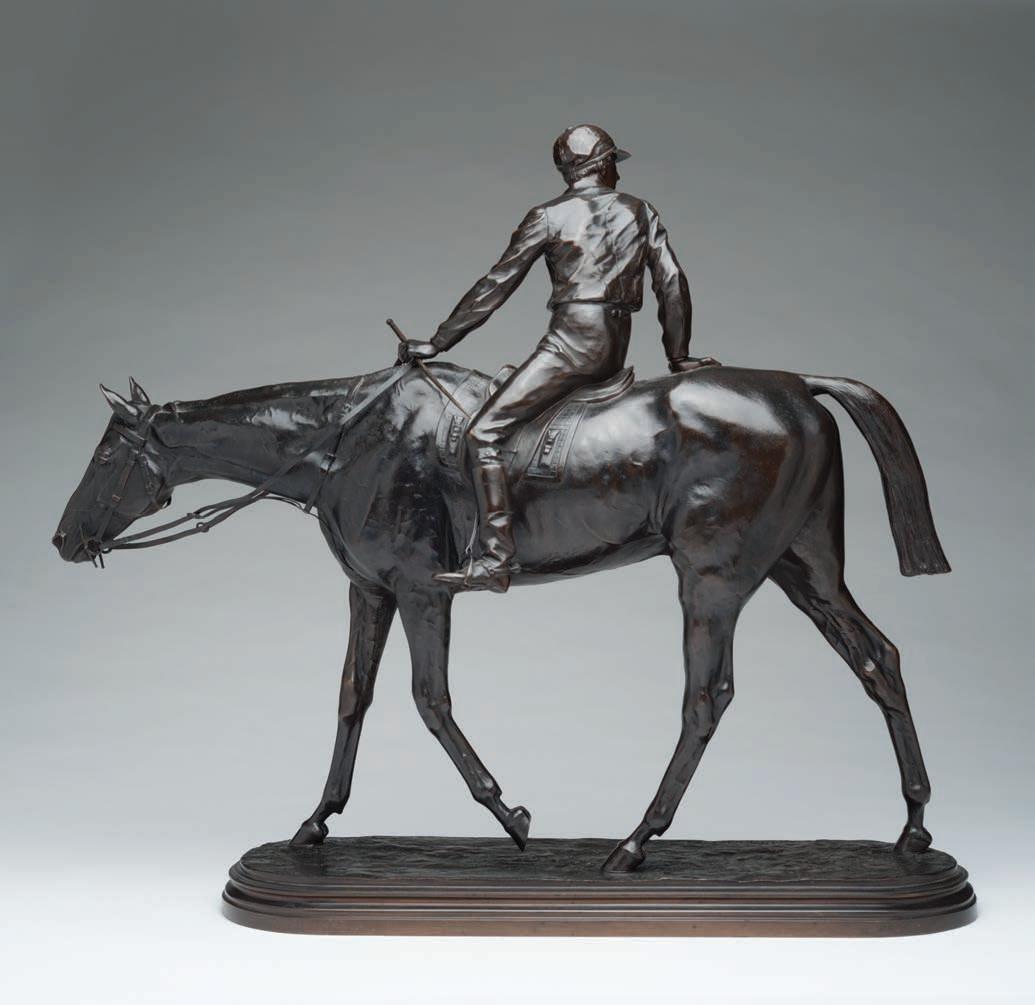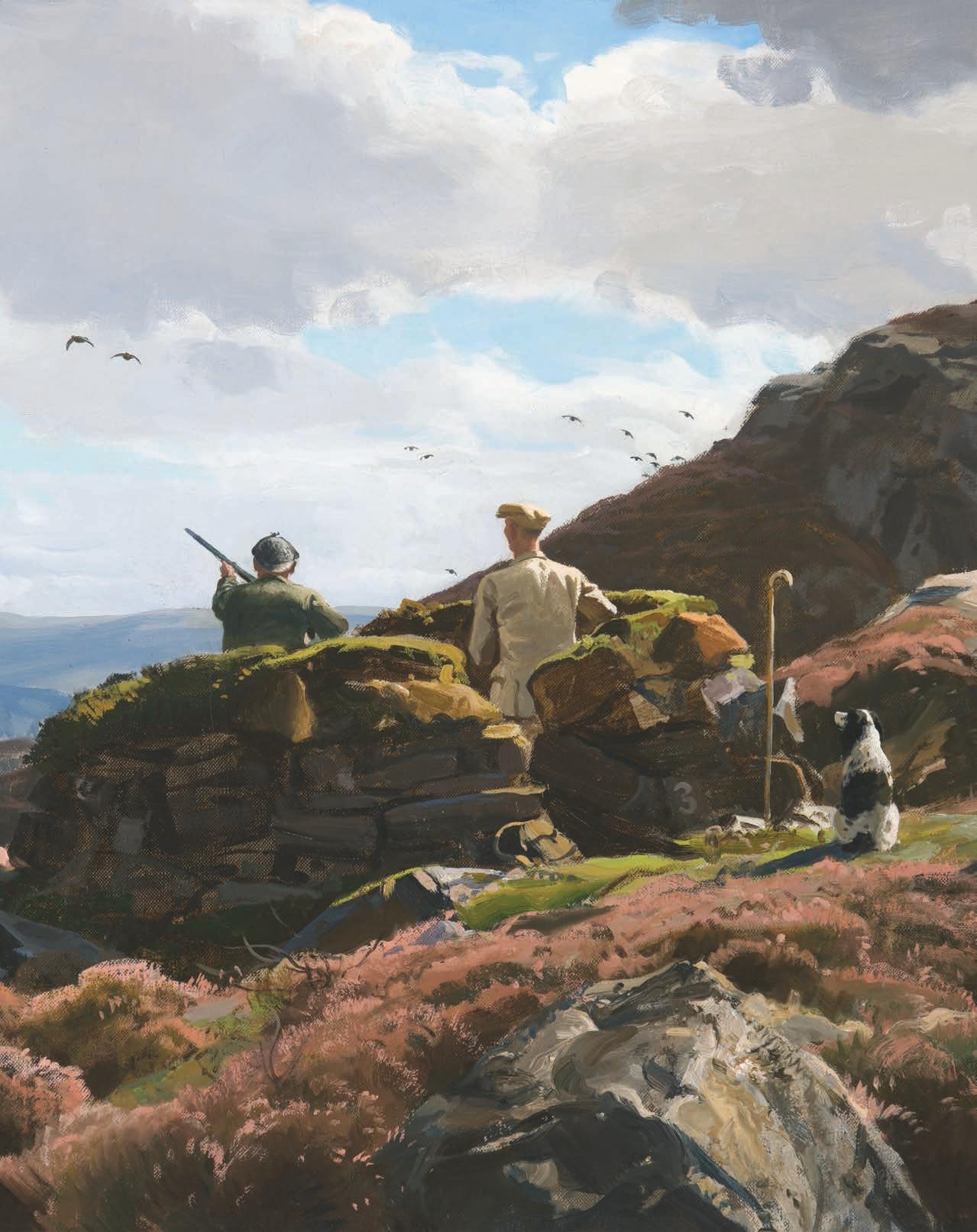

Important Sporting Paintings & Sculpture
Important Sporting Paintings & Sculpture
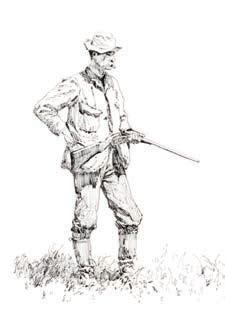
a catalog presented in collaboration
PETER L. VILLA FINE ART, LLC
American & European Paintings from the 18th – 21st Centuries
P.O. Box 143 – 10 Todd Avenue Peapack, New Jersey 07977 In New York by Appointment 212-371-1196
peter@plvillafineart.com www.peterlvillafineart.com and
RED FOX FINE ART
Sporting Paintings & Sculpture
P.O. Box 385 – 2 East Washington Street Middleburg, Virginia 20117 703-851-5160
F. Turner Reuter, Jr. tr@redfoxfineart.com www.redfoxfineart.com
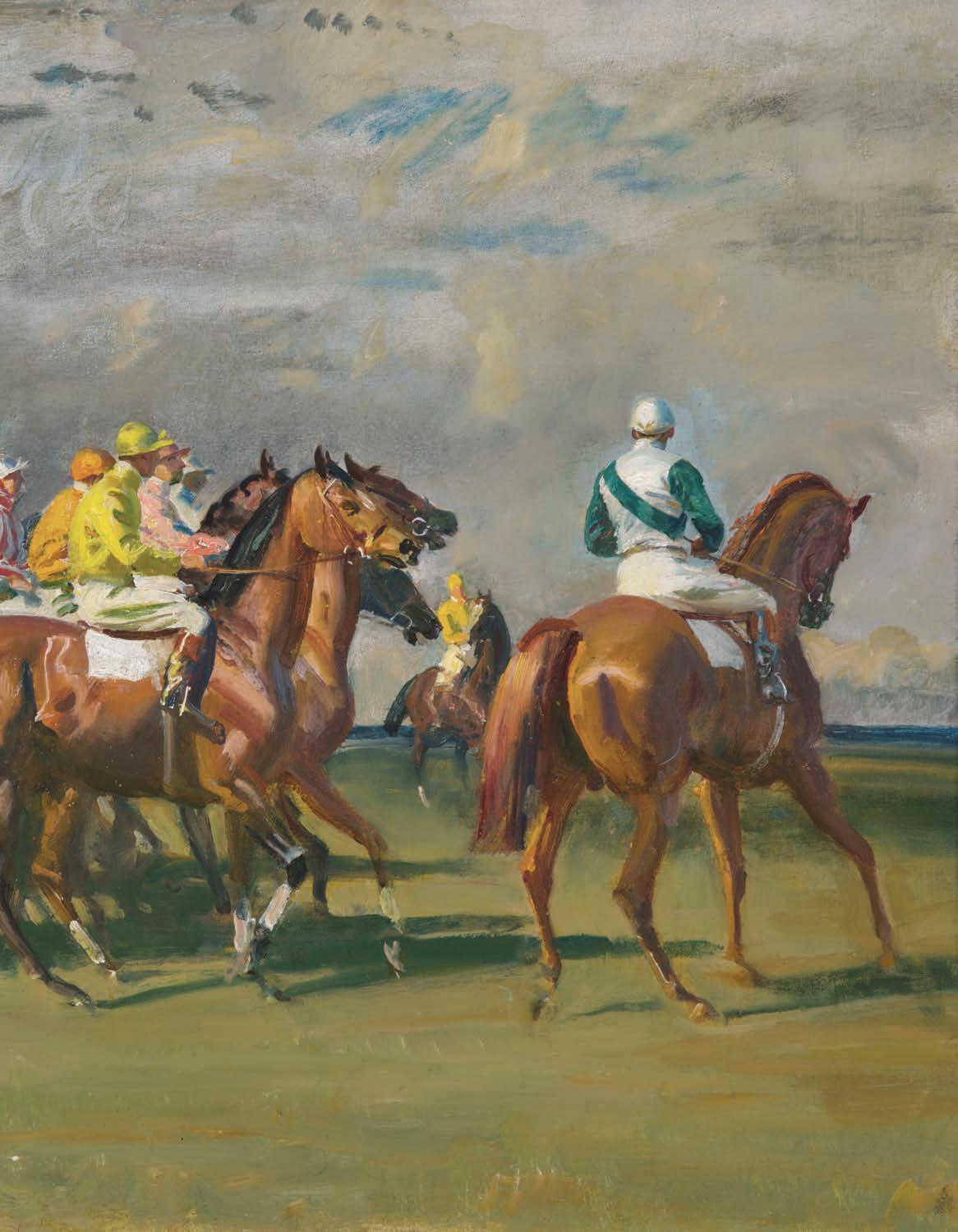
A Note of Introduction
Forty years of shared enthusiasm for the field sports and country life has inspired our decision to publish this collaborative catalog. By coincidence of timing and through the contributions of a generation of like-minded collectors, we are able to offer exceptional examples by celebrated sporting painters and sculptors, spanning a period of over 250 years. We are particularly fortunate to have an extraordinary assembly of works by Ogden M. Pleissner, recognized as one of the most accomplished American sporting artists of the 20th century.
It is immediately apparent that the artists presented in this catalog benefited from first hand experience. Accomplished sportsmen in their own right, they often traveled the world developing an intimate knowledge of the great variety of game, landscapes and sporting traditions familiar to their patrons. Their keen sense of observation combined with remarkable artistic talent created an enthusiastic demand for their work that continues to resonate with collectors today.
Please note that all paintings and sculpture are offered subject to prior sale. Artworks can be viewed by appointment, or by delivery to a buyer’s location on approval. Prices, provenance, and full details of each entry are available on request.
Peter L. Villa
Opposite: A.J. MUNNINGS, (detail) Plate 25
F. Turner Reuter, Jr.
Important Sporting Paintings & Sculpture
a catalog presented in collaboration
Peter L. Villa Fine Art & Red Fox Fine Art
Copyright 2018
Peter L. Villa Fine Art, LLC / Red Fox Fine Art All rights reserved.
No part of this publication may be reproduced, or stored in a retrieval system, or transmitted in any form or by any means - electronic, mechanical, photocopying, recording, or otherwisewithout written permission of the publishers.
ISBN-13: 978-0-692-09237-8 Library of Congress Control Number: 2018938276
Published in the United States by Peter L. Villa Fine Art, LLC & Red Fox Fine Art
Printed in the U.S.A. by District Creative Printing, 6350 Fallard Drive, Upper Marlboro, Maryland
Layout and Design: Andrew Hock
Artwork Photography: Brian Birlauf Photography Brandon Webster Photography
Front Cover: OGDEN M. PLEISSNER (detail) Plate 6
Opposite:
PERCIVAL LEONARD ROSSEAU (detail) Plate 17
Back Cover:
ISIDORE JULES BONHEUR Plate 29

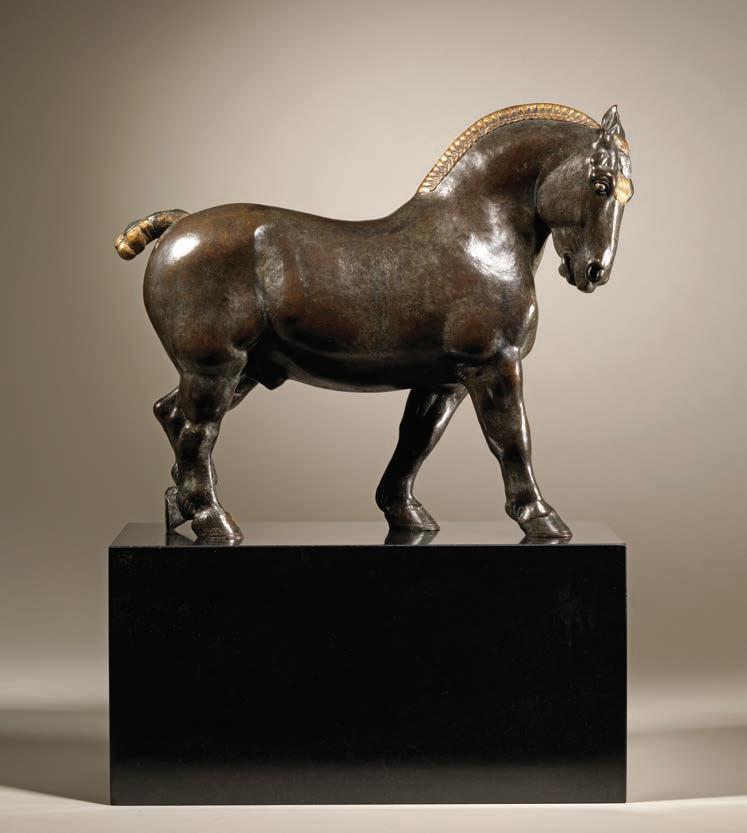
(American, 1877-1962)
Suffolk Punch, 1929
Signed, dated, numbered and inscribed on the marble base © HASELTINE, MCMXXIX, V, Suffolk Punch
Bronze; mottled brown and green patina with applied gold and silver highlights to the forelock, mane and tail bronze dimensions: 11 x 131/2 x 31/2 inches; marble base dimension: 61/2 x 131/2 x 6 inches
1.
HERBERT HASELTINE
HERBERT HASELTINE
Suffolk Punch, 1929
Exhibited:
Knoedler Gallery, Chicago, IL 1930
Note:
Haseltine said of the horse…“The minute I saw Subourne Premier, the magnificent stallion of the famous breed of chestnuts, all my troubles were forgotten and my only thought was to get to work.” Sudbourne Premier, was by the sire Sudbourne Beau Brocade out of the dam Sudbourne Moonlight. He was bred by Lord Manton, owned by Percy C. Vesty, Easton Park, Wickham Market and was foaled in 1919. Among many wins, Sudbourne Premier was First and Champion at the Show of Royal Agricultural Society of England 1921 and 1922; First and Champion at the Suffolk Show 1922 and 1924; First and Champion at the Woodbridge Show 1923 and First at the Derby Show in the same year.
Casting Note:
Haseltine produced the Suffolk Punch model in three sizes as a part of the British Champion Animals series. The large version, approximately one quarter life-size, was limited to just two examples with the first going to the Field Museum, Chicago, IL. The medium version was one eighth life-size and was produced on demand as a part of the complete set, although research suggests that less than ten casts of this set were made. Finally, a small version, one sixteenth in size of the model was produced and sold as a part of the complete set – just six of these were made. The present example is from the medium size edition and is the finest example we have seen of this model. Previous examples, with one exception, have had more traditional patinas and less or no gilding nor silver bows on the forelock and tail.
Literature:
Herbert Haseltine, An Exhibition of Sculpture of British Champion Animals, Knoedler Gallery, London, 1925, illus. pg. 9
Herbert Haseltine, An Exhibition of Sculpture, Knoedler Gallery, London, 1930, illus. no. 1
Herbert Haseltine: Exhibition of Sculpture of British Champion Animals, Field Museum, Chicago, IL, 1934, illus. cat. no. 3
Herbert Haseltine, American Sculptors Series, 1948, illus. pg. 41
Haseltine, Hirschl & Adler Galleries, New York, 1992, illus. pg. 30
The Haseltines, Arthur Ackermann and Peter Johnson Ltd., London,1998, illus. pg. 14
American Sculpture in the Metropolitan Museum of Art, Vol II, 2000, illus. pg. 609-614
Champion Animals, Sculptures by Herbert Haseltine, VMFA, Richmond, VA, 1996, pg. 26-27.
The Art of Ogden M. Pleissner
Overthe course of many years, a considerable number of artists have endeavored to capture the essence of fly-fishing for salmon and trout, gunning for waterfowl, shooting ruffed grouse and woodcock, quail or driven grouse; however few have managed to equal the work of Winslow Homer, Frank W. Benson, A.L. Ripley, and Ogden Pleissner.
Pleissner considered himself to be a “landscape painter who also likes to hunt and fish.” He is an artist whose beautiful renderings of the natural environment always leave out some detail for the mind’s eye to fill in, thereby drawing the viewer into the oil painting or watercolor. Pleissner felt that “a fine painting is not just the subject ... it is the feeling conveyed of form, bulk, space, dimensionality, and sensitivity. The mood of the picture, that is the most important.”
Thomas S. Buechner, an old friend and an authority on art history, has this to say about Ogden Pleissner: “There is a special joy in witnessing a champion performance –in tennis, politics, or in painting. Anyone who knows anything about recording the visual world in paint must be awestruck by Pleissner’s performance. Extremely complicated subjects are rendered so accurately, so spontaneously, so appreciatively that comparison with Homer and Sargent is inevitable … Catching a fish or fueling a plane may be the subject, but the picture is about an emotion that the
artist has; he uses these things, arranges them, colors them, lights them to convey a mood ... Pleissner invites us to transcend our focus on action to see the whole scene –quietly, and from a little distance.”
Sporting art is exactly that, art with a sporting theme. There is obvious or hidden prey in the picture and game is depicted in a well-painted landscape that may also include a figure holding a rod or gun; or simply could be an image of a stream, river, marsh, moor or hillside where one senses that a fish or bird lies in waiting.
Artists who have the potential to create great sporting art know well the habits of the wild creatures, and have committed to memory every detail of their habitats. These artists have experienced the thrill of an Atlantic salmon or a large trout taking a well-presented fly, the explosion of a bursting covey of quail, sunrise over a duck marsh, running the rapids in a canoe, or sleeping under the stars.
Ogden Pleissner is one of these men and his great skill as an artist can be recognized by the fine collection of his oils and watercolors illustrated in this catalog.
Peter Bergh Edwards, Colorado
Author of The Art of Ogden M. Pleissner
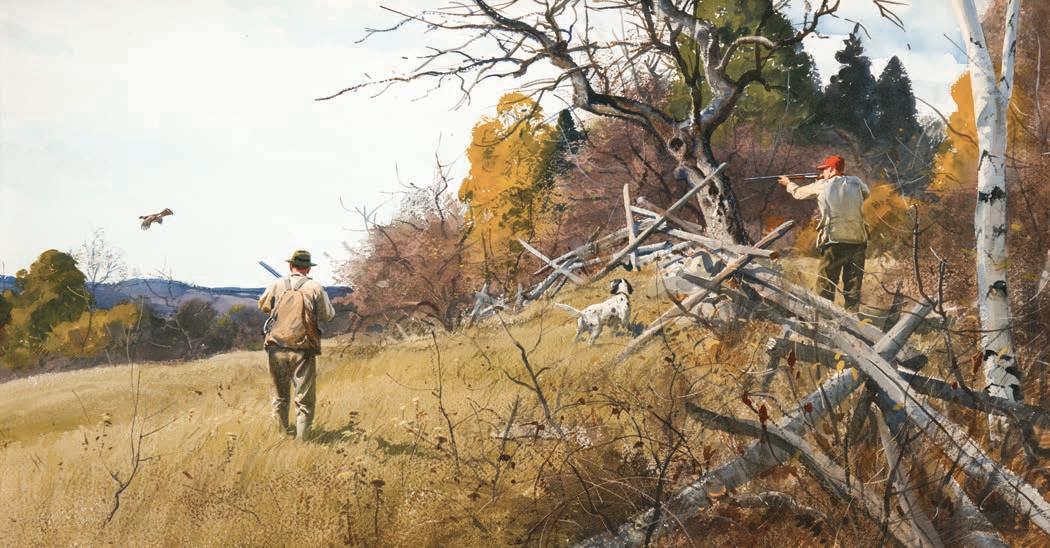
(American, 1905-1983)
Grouse Shooting Signed Watercolor on paper, 15 x 29 inches
2.
OGDEN M. PLEISSNER
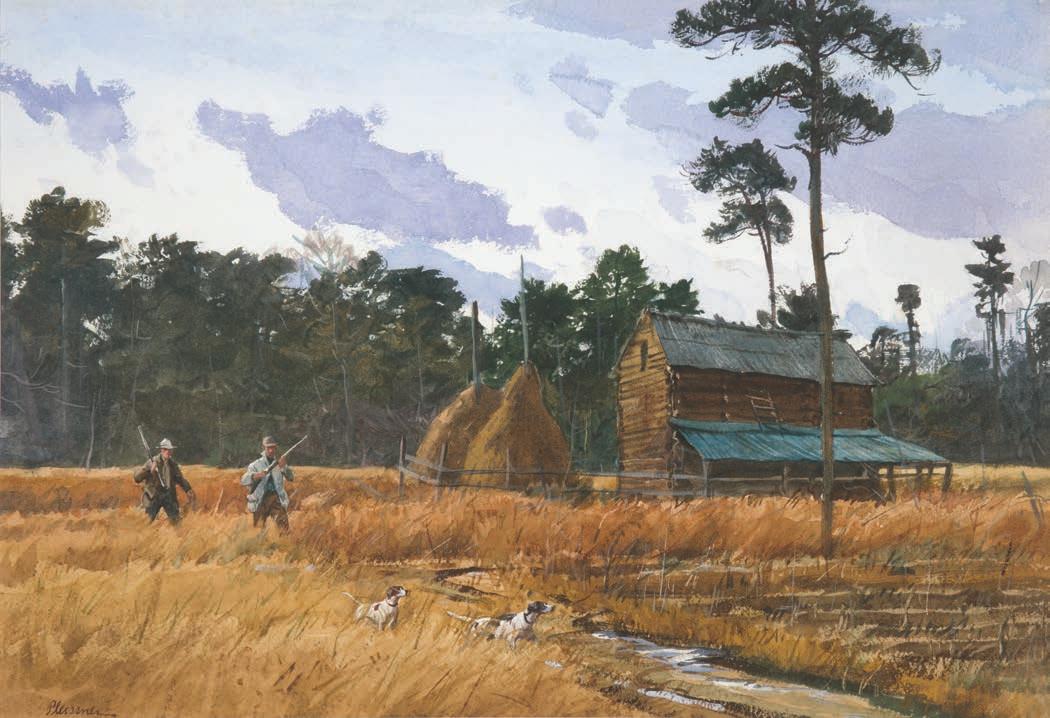
(American, 1905-1983)
Edge of the Cotton Field, Quail Shooting
Signed
Watercolor on paper, 14 1/2 x 21 1/2 inches
3.
OGDEN M. PLEISSNER

(American, 1905-1983)
The Covey Rise Signed, inscribed in pencil in the margin with date 1960
Watercolor on paper, 16 1/2 x 27 1/2 inches
4.
OGDEN M. PLEISSNER
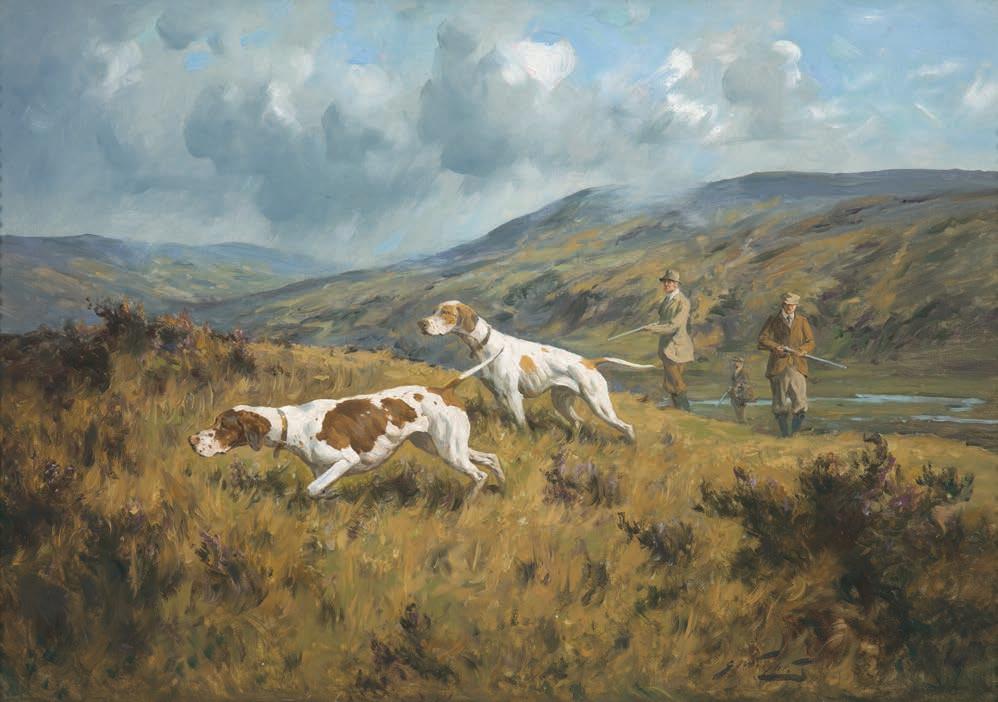
(British, 1860-1942)
On the Moor – Walking up Signed, painted circa 1915 Oil on canvas, 14 x 201/8 inches
5.
GEORGE WRIGHT
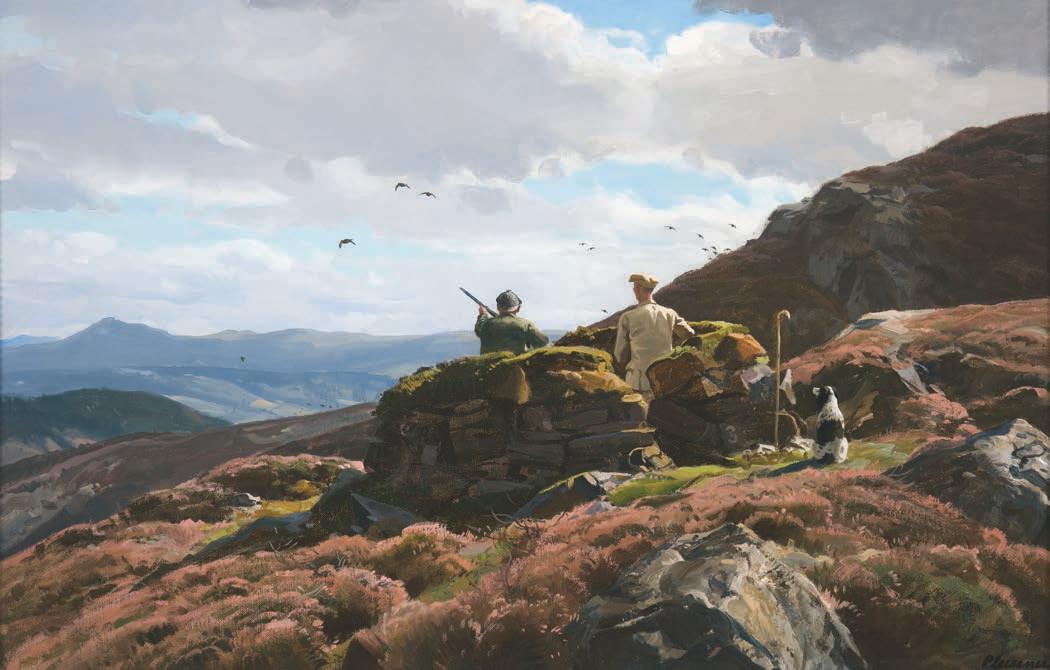
(American, 1905-1983)
Driven Grouse, Perthshire
Signed Oil on canvas, 18 1/2 x 28 inches
6.
OGDEN M. PLEISSNER
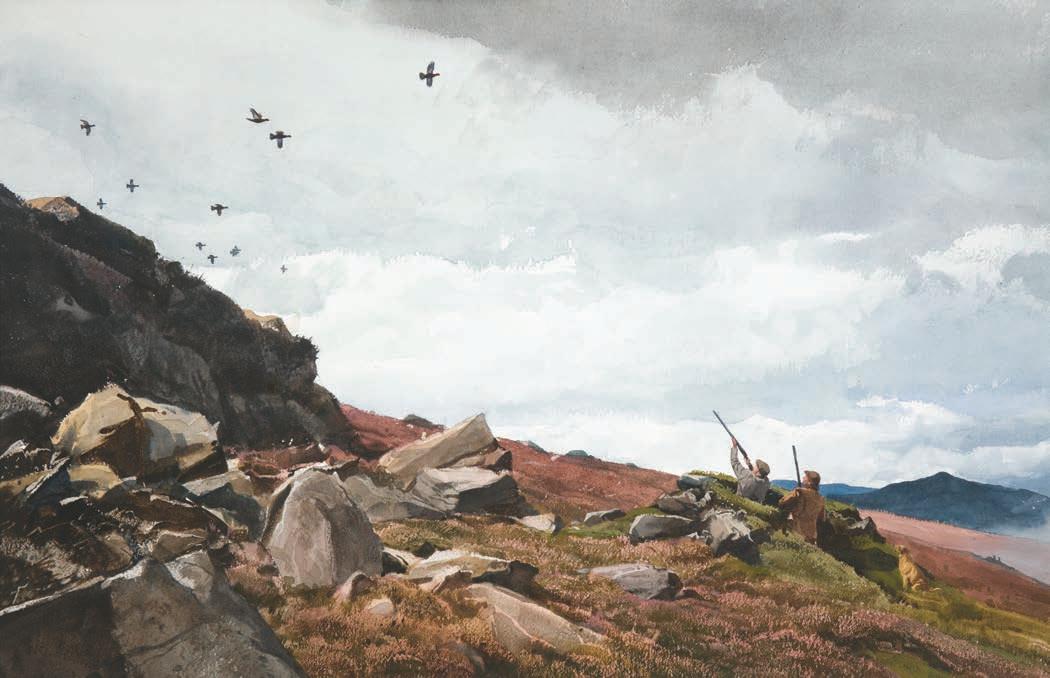
(American, 1905-1983)
A High Shot, Perthshire Signed Watercolor on paper, 18 x 28 inches
7.
OGDEN M. PLEISSNER
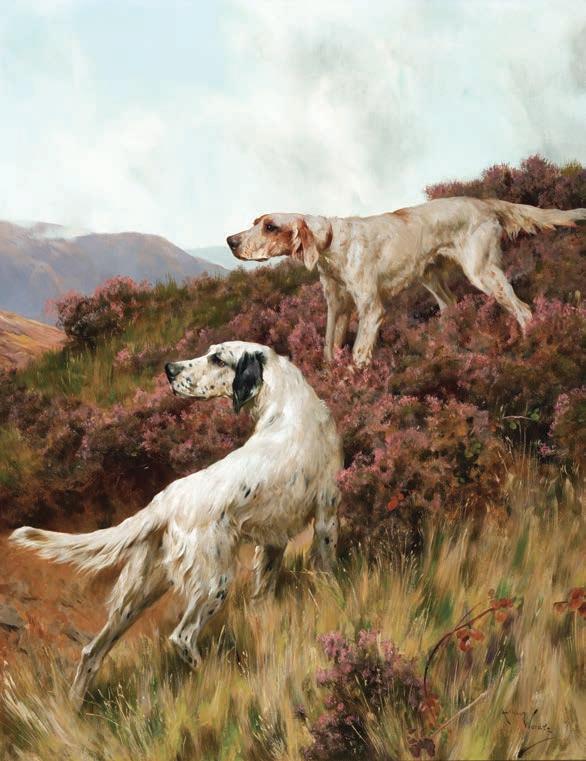
(British, 1864-1949) Setters on the Moor Signed Oil on canvas, 24 x 19 inches
8.
ARTHUR WARDLE
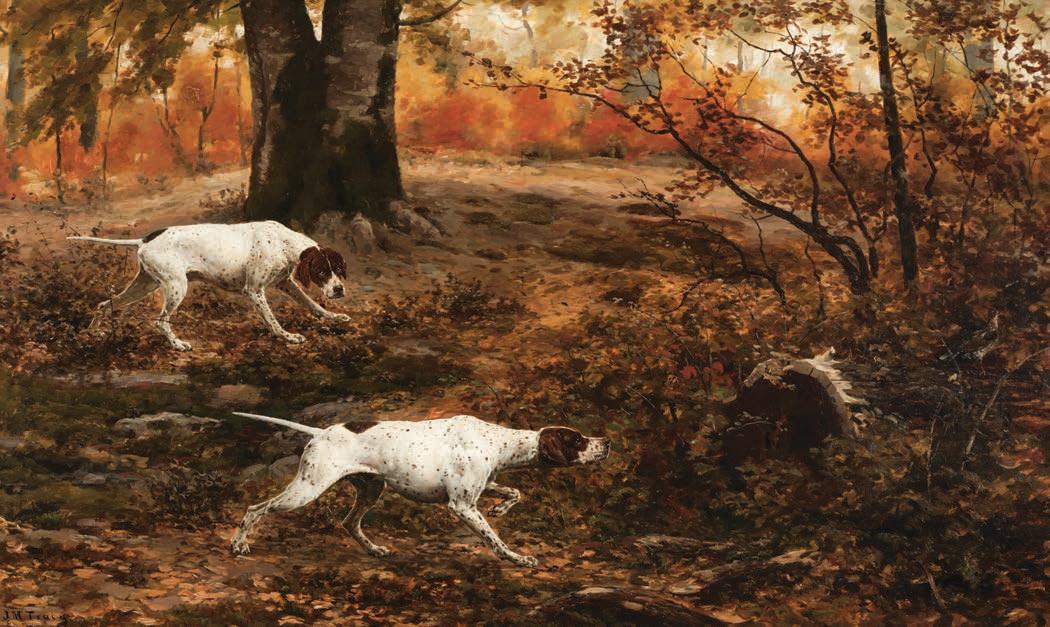
(American, 1843-1893)
In the Grouse Woods
Signed, painted circa 1886 Oil on canvas, 30 x 50 inches
9.
JOHN MARTIN TRACY
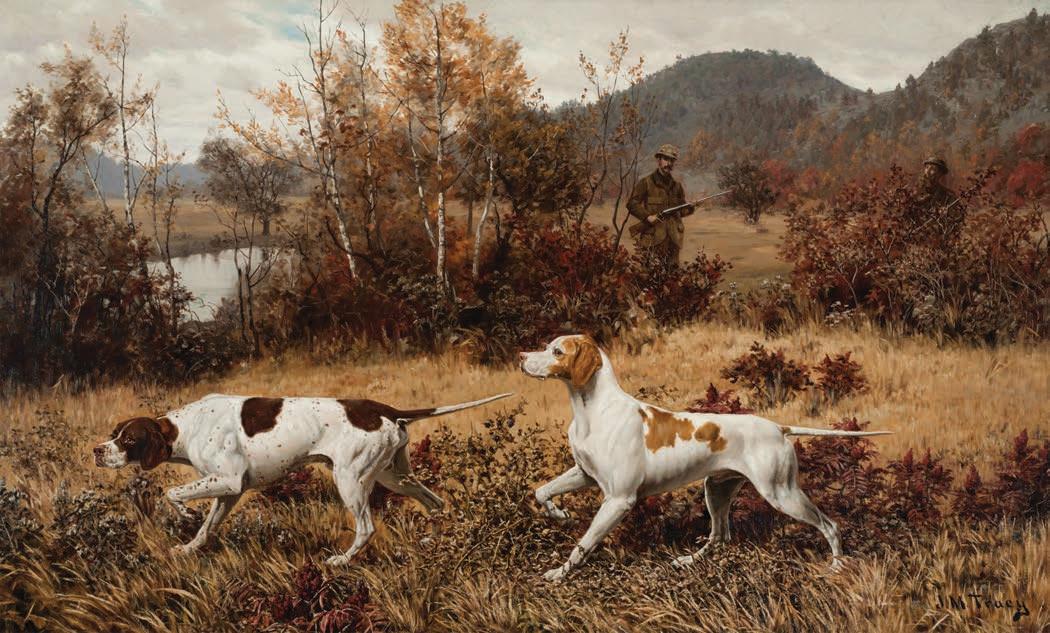
(American, 1843-1893)
In Quail Country Signed, painted circa 1886 Oil on canvas, 30¼ x 50¼ inches
10.
JOHN MARTIN TRACY
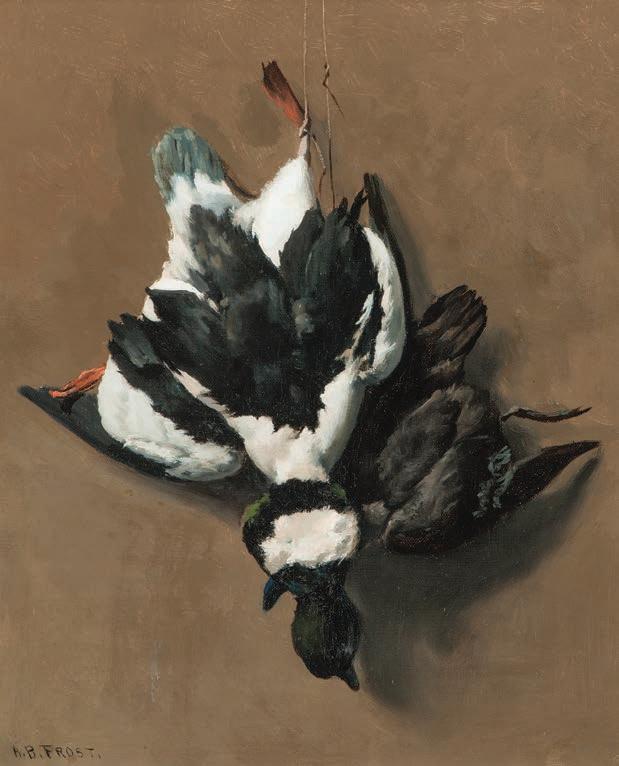
(American 1851-1928) Still Life of Hanging Ducks Signed Oil on canvas, 18 x 15 inches
11.
ARTHUR BURDETT FROST
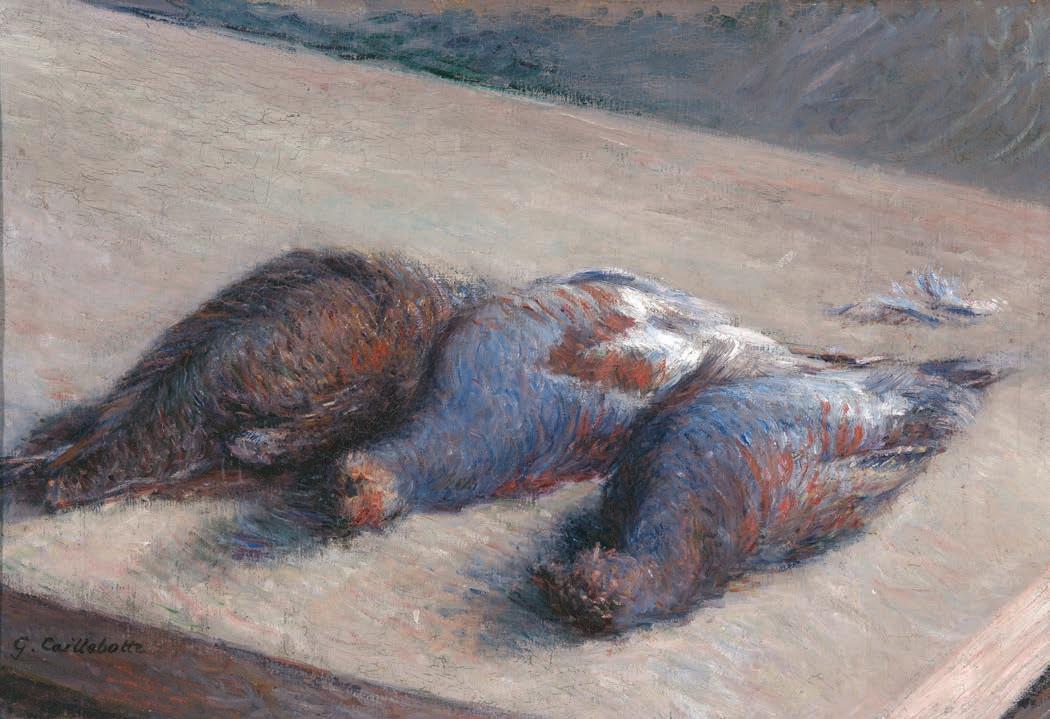
(French, 1848-1894)
Trois Perdrix sur une Table Signed, painted circa 1880 Oil on canvas, 15 x 22 1/2 inches
12.
GUSTAVE CAILLEBOTTE
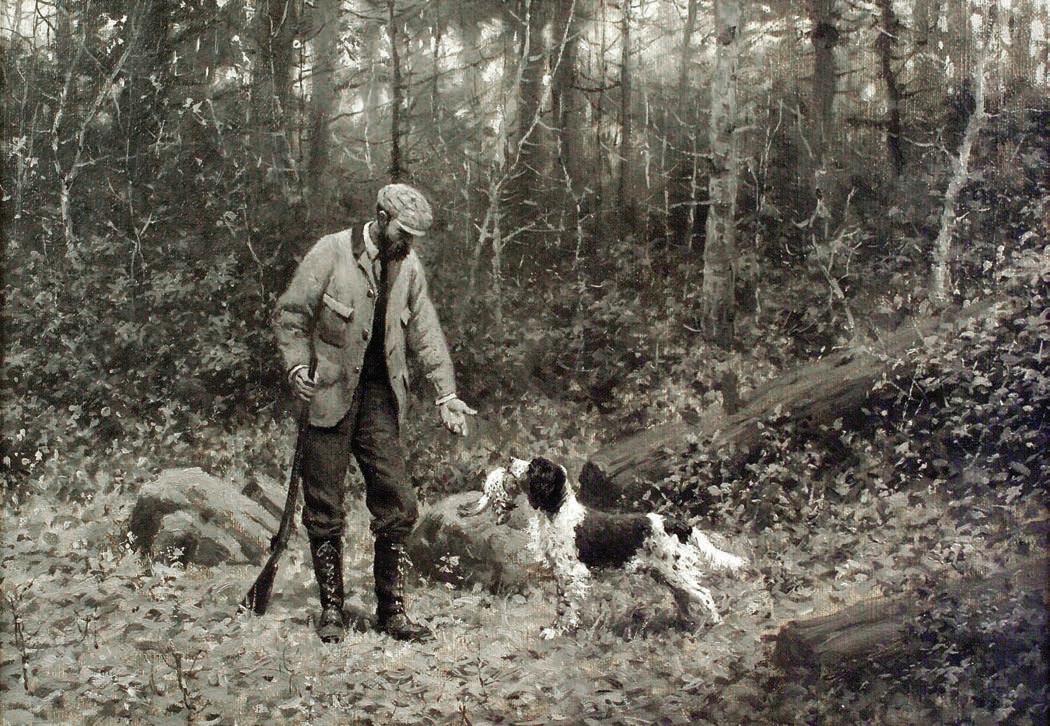
(American, 1851-1928) Good Shot and Good Dog Oil on canvas en grisaille, 16 1/2 x 23¼ inches
13.
ARTHUR BURDETT FROST
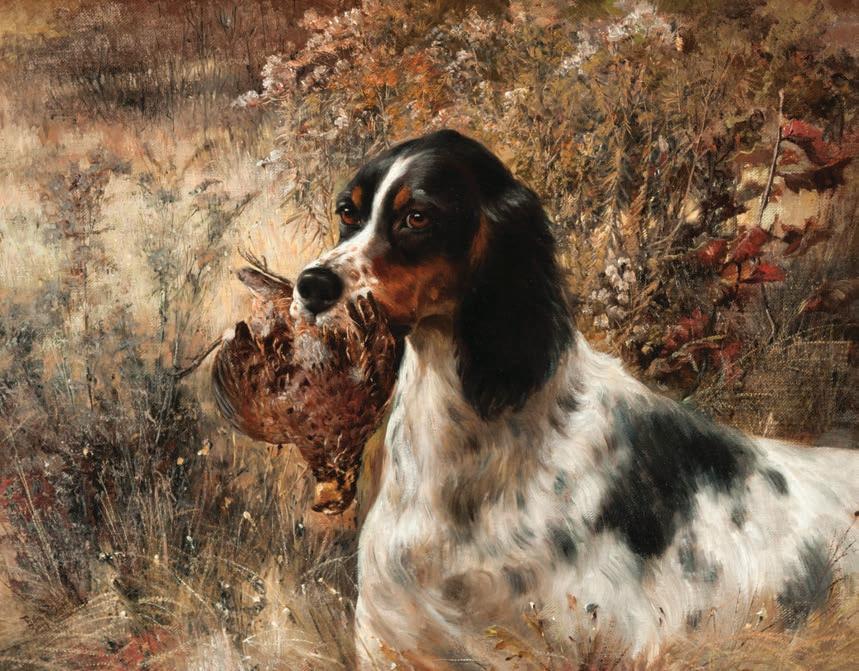
(American, 1858-1928) A Setter Retrieving a Quail Signed and dated 1891 Oil on canvas, 22 x 28 inches
14.
EDMUND HENRY OSTHAUS

(American, 1896-1969)
Late Season Quail Shooting
Signed, dated 1938 and inscribed as titled verso Watercolor on paper, 15 x 24 inches
15.
AIDEN LASSEL RIPLEY
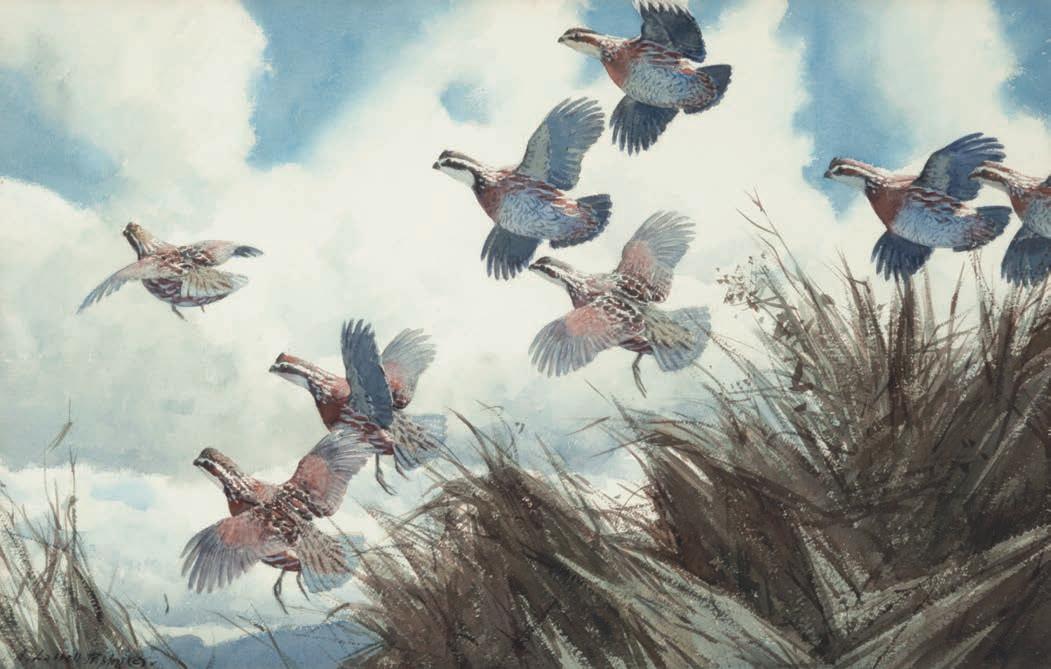
(American, 1896-1969) Covey Rise
Signed Watercolor on paper, 18 1/2 x 29¼ inches
16.
AIDEN LASSEL RIPLEY
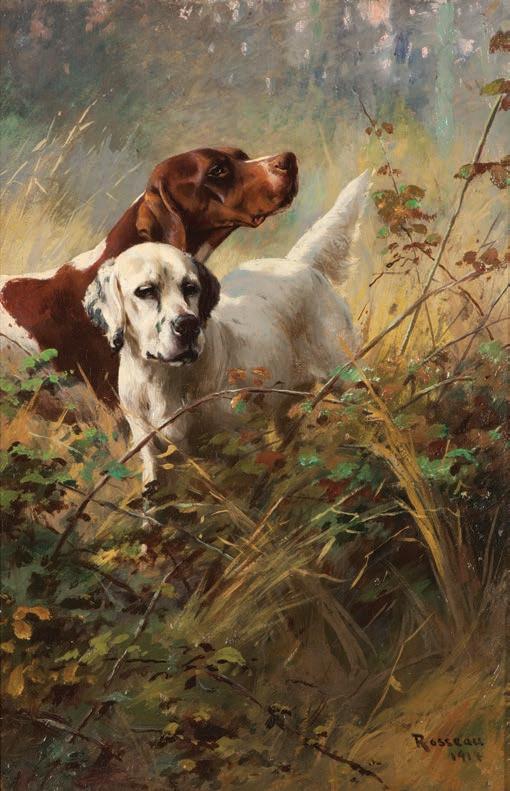
(American, 1859-1937)
A Brace on Point Signed and dated 1914
Oil on canvas, 16 x 10¾ inches
17.
PERCIVAL LEONARD ROSSEAU
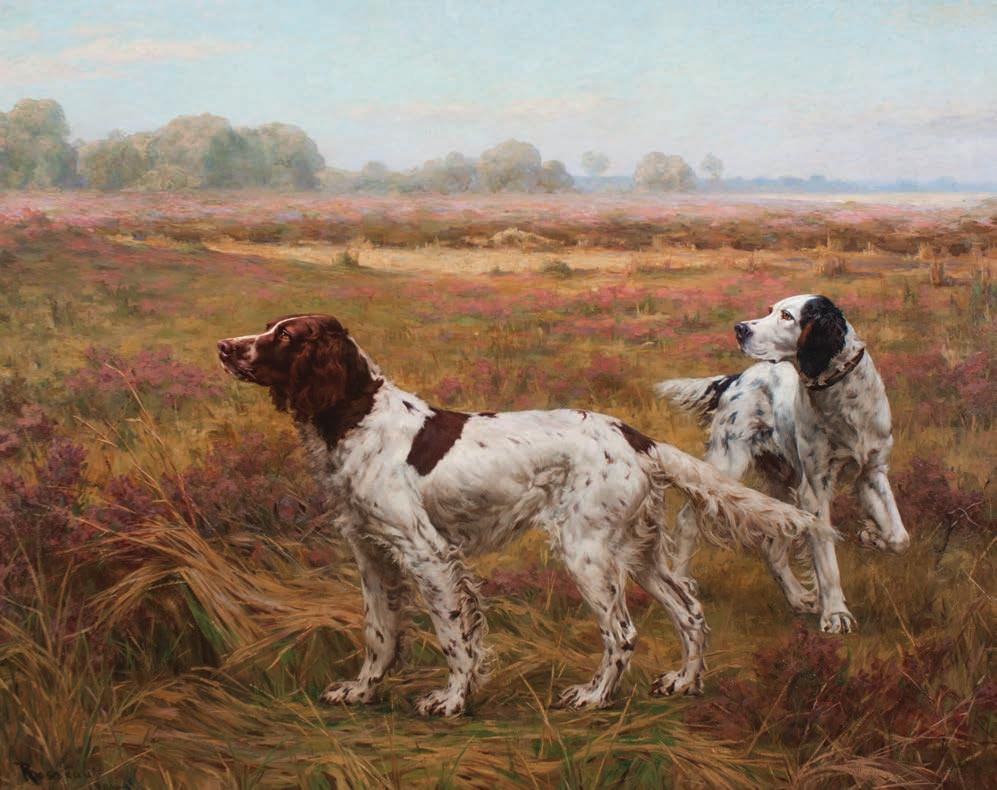
(American, 1859-1937)
Setters in a Landscape Signed and dated 1904 Oil on canvas, 57 x 71 inches
18.
PERCIVAL LEONARD ROSSEAU
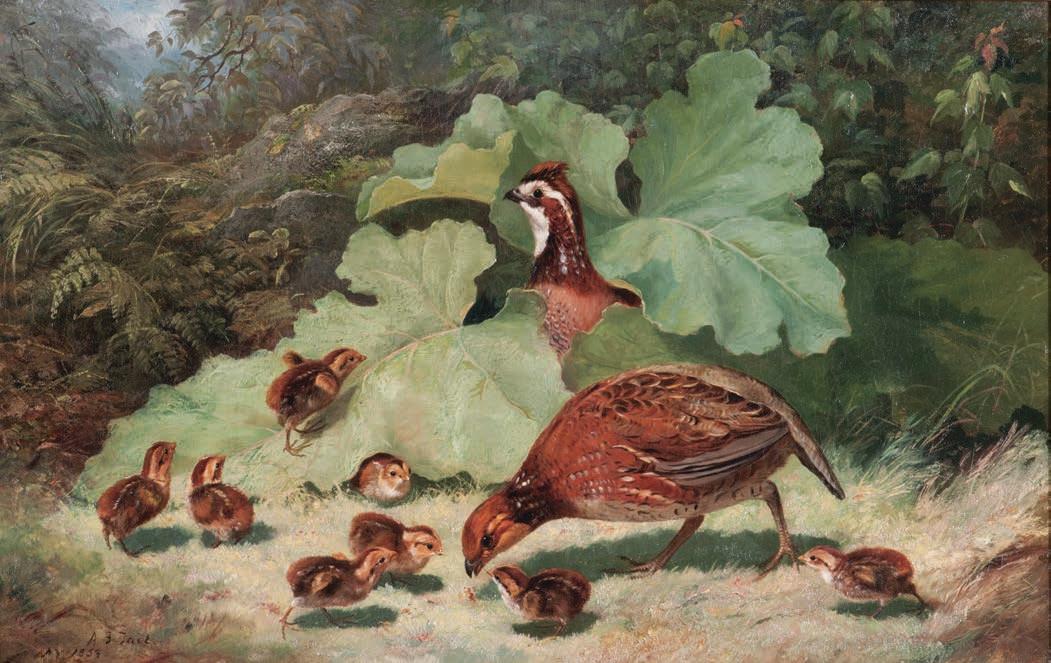
(American, 1819-1905) Quail and Young
Signed, inscribed and dated NY 1859 Oil on canvas, 14¼ x 22¼ inches
19.
ARTHUR FITZWILLIAM TAIT
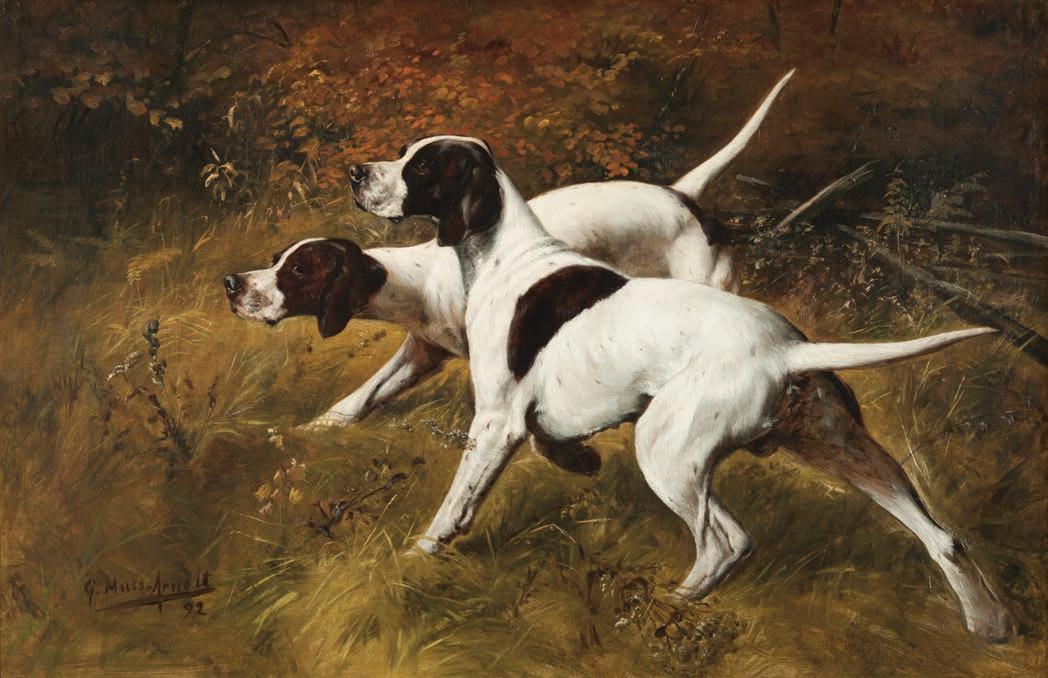
(American, 1858-1927) Pointers in a Landscape Signed and dated 92 Oil on canvas, 22 x 34 inches
20.
GUSTAVE MUSS ARNOLT
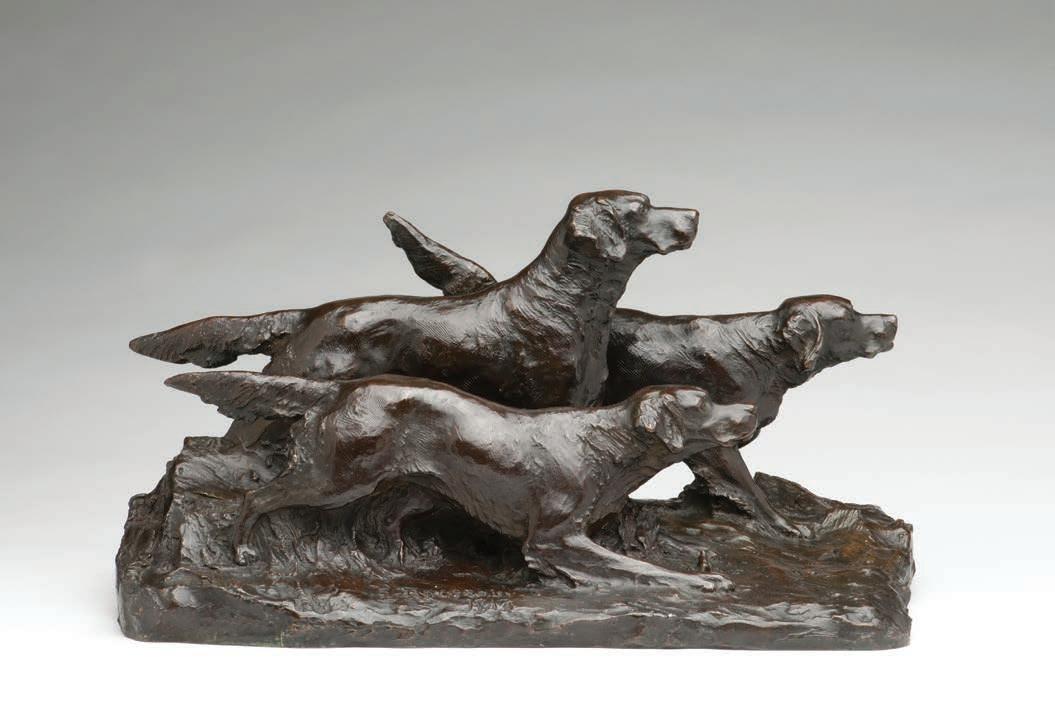
PERCIVAL LEONARD ROSSEAU
(American, 1859-1937)
Setters on Birds
Signed, dated 1913 and stamped Roman Bronze Works N-Y
Bronze; edition, cast unique, rich dark brown patina, 8 1/2 x 15 1/2 x 9 1/2 inches
21.
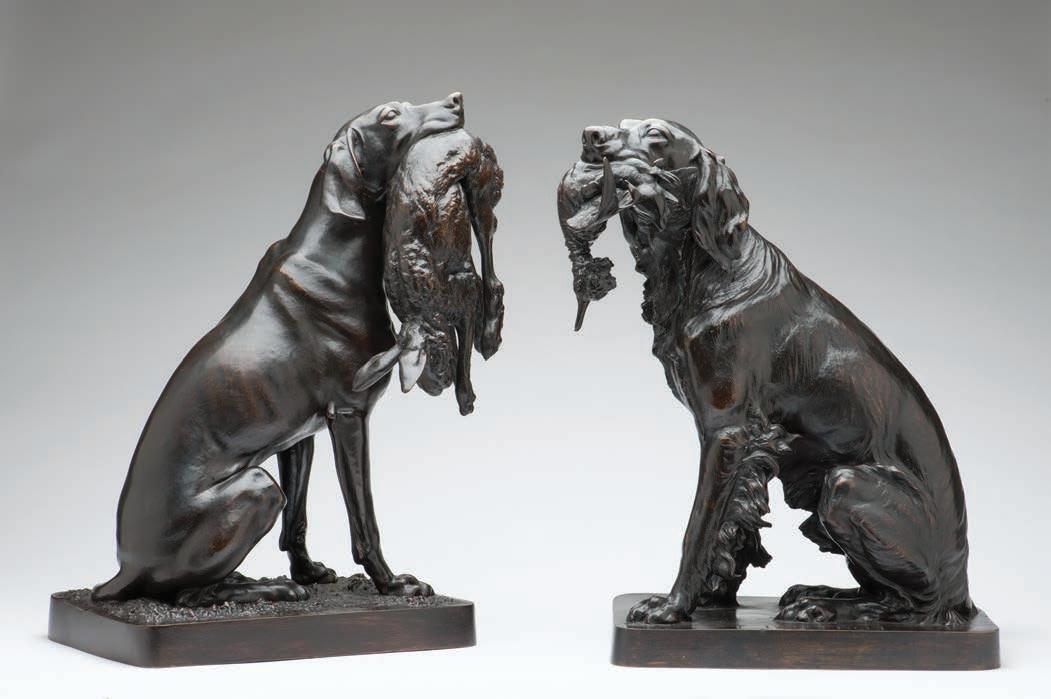
FERDINAND PAUTROT
(French, 1832-1874)
Gun Dogs and Game, a pair
Both signed and stamped Admis aux Beau Arts and Ball, Black & Co., New –York Bronze; dark brown patina, 18 1/2 x 14 x 8 1/2 inches
22.
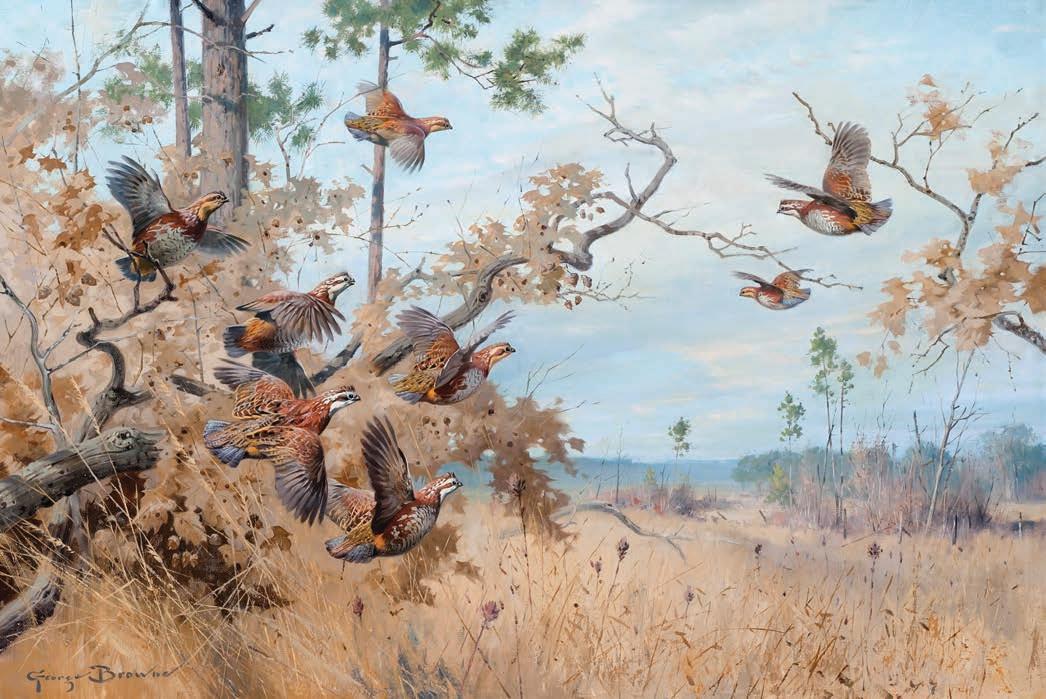
1918-1958)
Pine Lands, 1956
23.
GEORGE BROWNE
(American,
Quail in the
Signed Oil on canvas, 24 x 36 inches
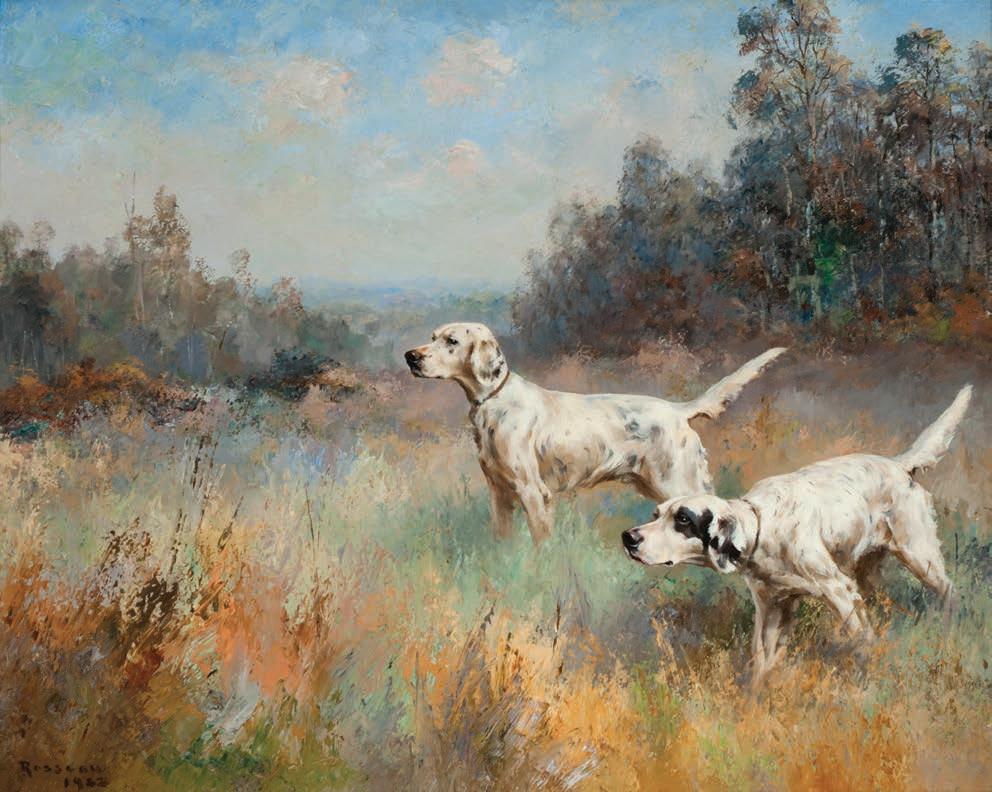
(American, 1859-1937)
Morning: Setters on Point
Signed, dated 1922 and inscribed verso,“Morning” / Banrock Tippet B. and Sam / Cat. # 13 Oil on canvas, 26 x 32 inches
24.
PERCIVAL LEONARD ROSSEAU
SIR ALFRED JAMES MUNNINGS, PRA
Under Starter’s Orders, Newmarket
Provenance:
Private Collection, Great Britain
Mrs. C. Oliver Iselin, III, Virginia, USA
Sale Christie’s, New York, Important British & American Sporting Paintings, June 10, 1983, lot #194
A Private American Collection, 1983 until the present
Munnings’ love of color, equine movement and the drama of the racing scene led him to Newmarket where he had been given access to the course’s starting area. There, for four decades, he would record the endless motifs of horses in the moments before the start of a race.
Munnings repeatedly painted the theme of horses jostling for position for the most advantageous start. Not only did this shift the colorful highlights of jockeys’ silks and gleaming equine coats, but the various groupings provided Munnings with opportunities to play with the viewers’ visual subconscious. Degas was renowned for the same technique in his ballet paintings, in which the figures’ placement encouraged the mind to generate movement.
In the third volume of his autobiography, Munnings describes his favorite Newmarket course: “I am standing on the course - the most beautiful course in the world ... I am looking at the scene, the old, old scene – a centuries old scene ... seeing visible beauty; the grouping, the movement
Literature:
Sir Alfred Munnings, The Finish, London, 1952, a larger related version titled Moving Up illustrated between pages 216 & 217.
– colour, all dependent on the lighting, the sky ... a large field waiting, waiting, regrouping ... what a sight for the artist! with the long shadows and the lights on the boots, lights on the horses ... ” (Munnings, The Finish, 1952, pages 216-17).
In this work, Munnings has disturbed a frieze configuration by angling the first and last prominent horses from the main line of runners. The last horse is shown ready to bolt, subconsciously propelling the group’s forward motion. The first horse, on the other hand, is positioned inward, holding back the perceived forward movement that the last horse has generated. This semicircular arrangement suggests that Munnings wanted to emphasize the containment of the runners who are “under starter’s orders”.
We are grateful to Lorian Peralta-Ramos for kindly assisting in the cataloguing of this work, which will be included in her forthcoming catalog raisonné of Sir Alfred James Munnings, PRA.
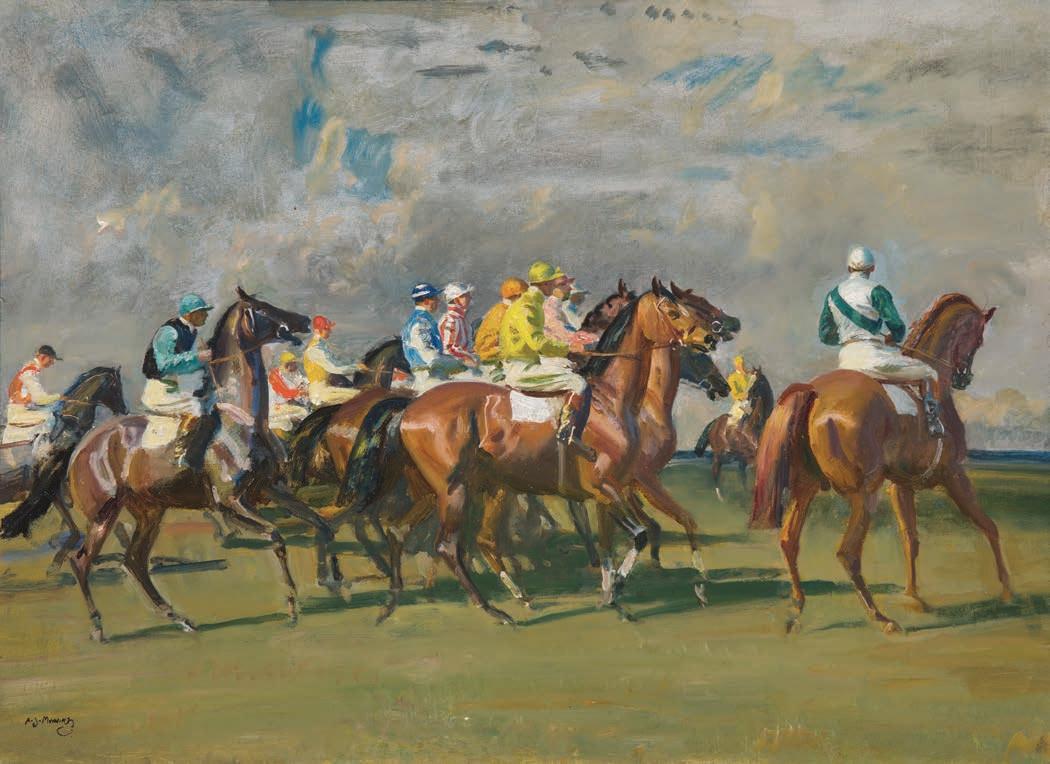
25. SIR
(British, 1878-1959) Under Starter’s Orders, Newmarket Signed Oil on board, 17 1/2 x 24 inches
ALFRED JAMES MUNNINGS, PRA
EDGAR DEGAS
Cheval faisant une descente de main, 1865-1881
Note:
This bronze was cast by the lost wax process at the Hébrard Foundry, Paris prior to 1924. Before casting it was signed, stamped and numbered in the wax Degas A.A. Hébrard Cire Perdue 22 /M
Provenance:
Acquired from Hébrard, by Walter Halvorsen, Glasgow, March 1, 1924
Alex Reid, Glasgow
Sir David Cargill, Lannock
Sotheby's, London, March 23, 1983
Private Collection, USA
Sladmore Gallery, London, 2012
Casting Note:
Of the 150 or so wax models found in Degas's studio at the time of his death 72 were deemed in good enough condition to be moulded, a task entrusted to the Hébrard foundry. Hébrard's contract with the family was to cast an edition of 20 of these 72 models (which he inscribed A to T). In addition, he was to provide a full set for the Degas family (inscribed 'HER.D' standing for ‘Hériteurs Degas’) as well as being allowed a full set for himself (inscribed 'HER'), making a total of twenty-two sets in all.
For stock control and accounting purposes Hébrard allocated all the chosen wax models a number from 1 to 72 and the relevant number appears inscribed on each individual bronze and each bronze bears the Hébrard foundry stamp applied before casting into the wax: 'A. A. Hébrard Cire Perdue'.
The full set of 72 works was first exhibited in 1921 at the Galerie Hébrard. The casting of 22 sets of 72 figures (1584 in total) would have been a mammoth task, and while they began in 1919 and continued throughout the 1920s and 1930s until the foundry closed its doors in 1936, even then, not all of the casts of each model were made.
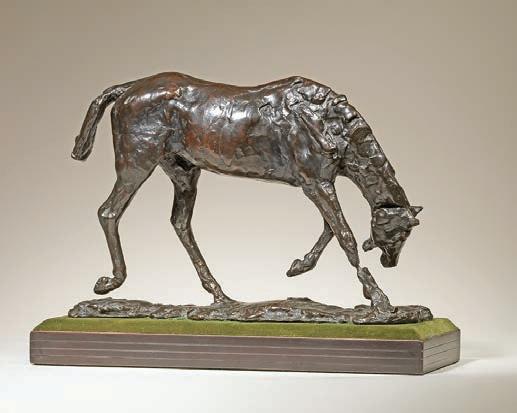
The Hébrard foundry’s working practice was to produce a ‘modèle’ in bronze which was kept as a benchmark against which all subsequent casts in an edition could be checked. The existence of the ‘modèle’ set of the Degas bronzes was however unrecorded and these only surfaced in the mid 1970’s – they were exhibited at the Lefevre Gallery in London and sold to the Norton Simon Museum, California in 1976. Thus a potential total of 23 examples in bronze could exist of each of the 72 chosen models.
The original wax working model of this piece survives and is in the National Gallery of Art, Washington, D.C. (gift of Mr and Mrs Paul Mellon 1991). Bronze examples are in the following museums: The Musée d'Orsay, Paris; the Metropolitan Museum of Fine Art, New York and the Norton Simon Museum, California among others.
Please contact us for a comprehensive essay related to this cast of Cheval faisant une descente de main, 1865-1881, including exhibition records and references in literature.
Dimensions including base: 8 x 12 x 4 inches

EDGAR DEGAS
(French, 1834-1917)
Cheval faisant une descente de main, 1865-1881
Signed, inscribed and numbered Bronze; rich reddy brown patina with dark brown undertones, 7 x 11 x 31/2
26.
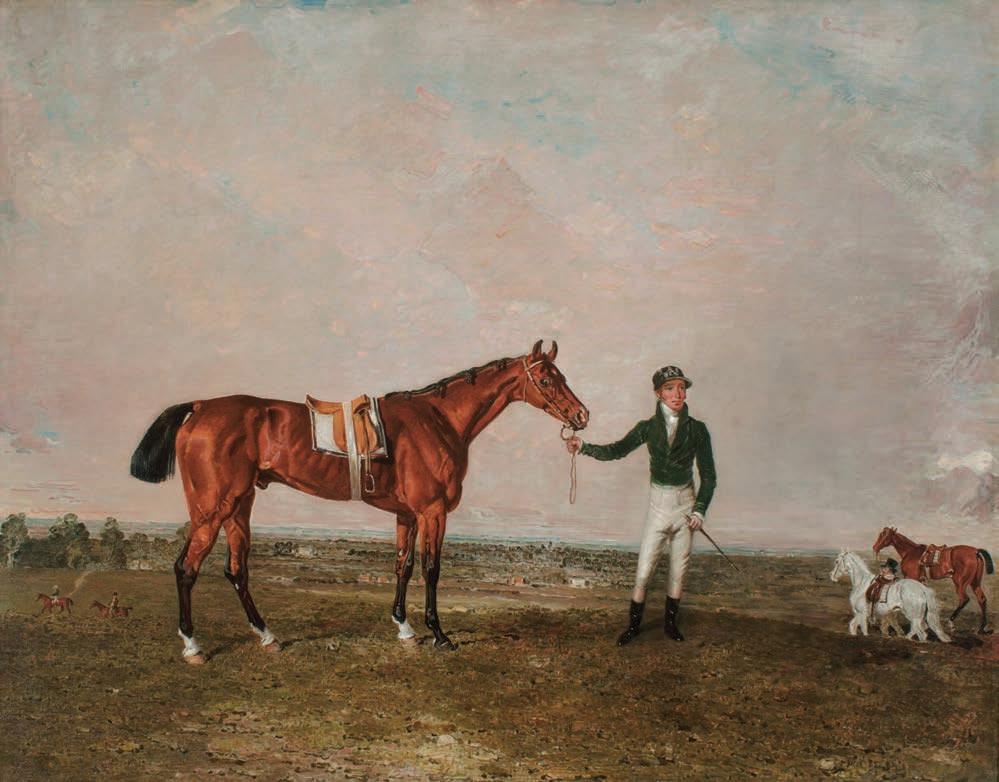
BENJAMIN
(British, 1768-1835)
Zinganee, Held by Sam Chifney, Jr. Wearing Lord Chesterfield’s Colors After Winning the Oatlands Stakes, Newmarket, circa 1829
Oil on canvas, 40 x 51 inches
27.
MARSHALL
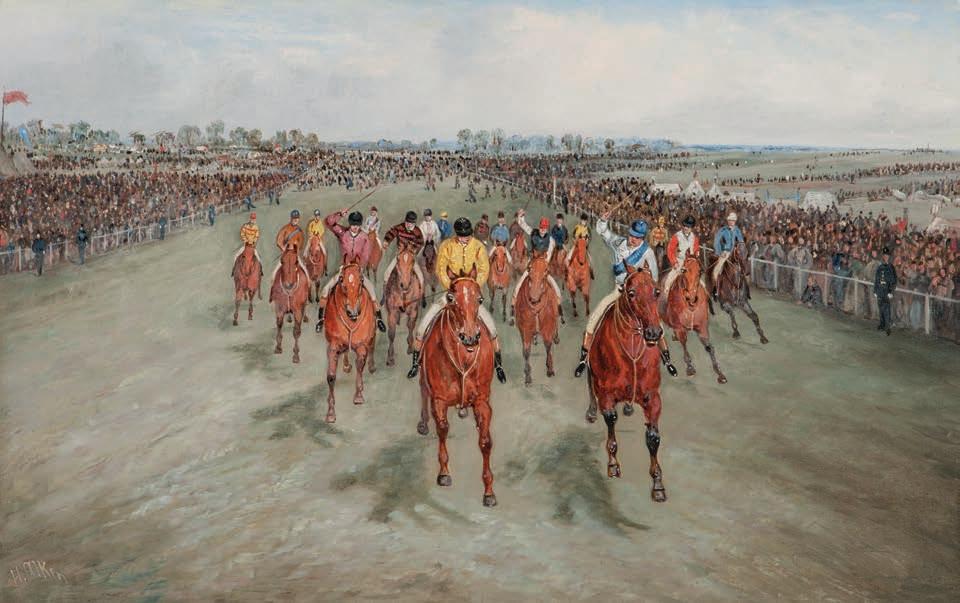
(British, 1810-1894)
The Epsom Derby, 1880, “Bend Or” with Fred Archer up Beating “Robert the Devil” with Rossiter up Signed Oil on panel, 11 x 17 inches
28. HENRY ALKEN
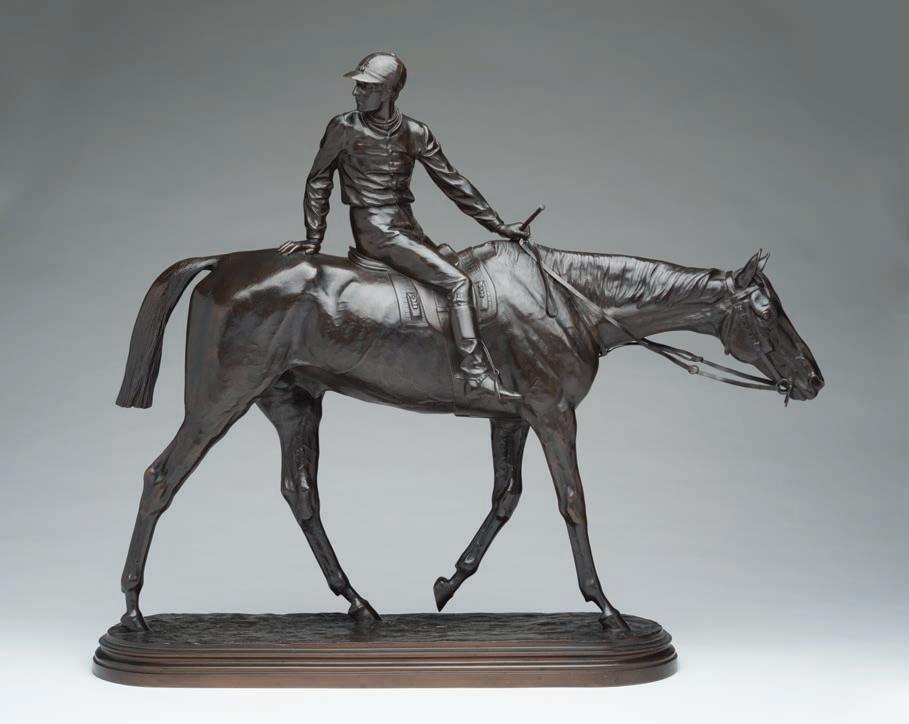
(French, 1827-1901)
Retour au Pesage
Signed and stamped Peyrol
Bronze; medium to dark brown patina, 21¼ x 24 x 7 inches
29.
ISIDORE JULES BONHEUR
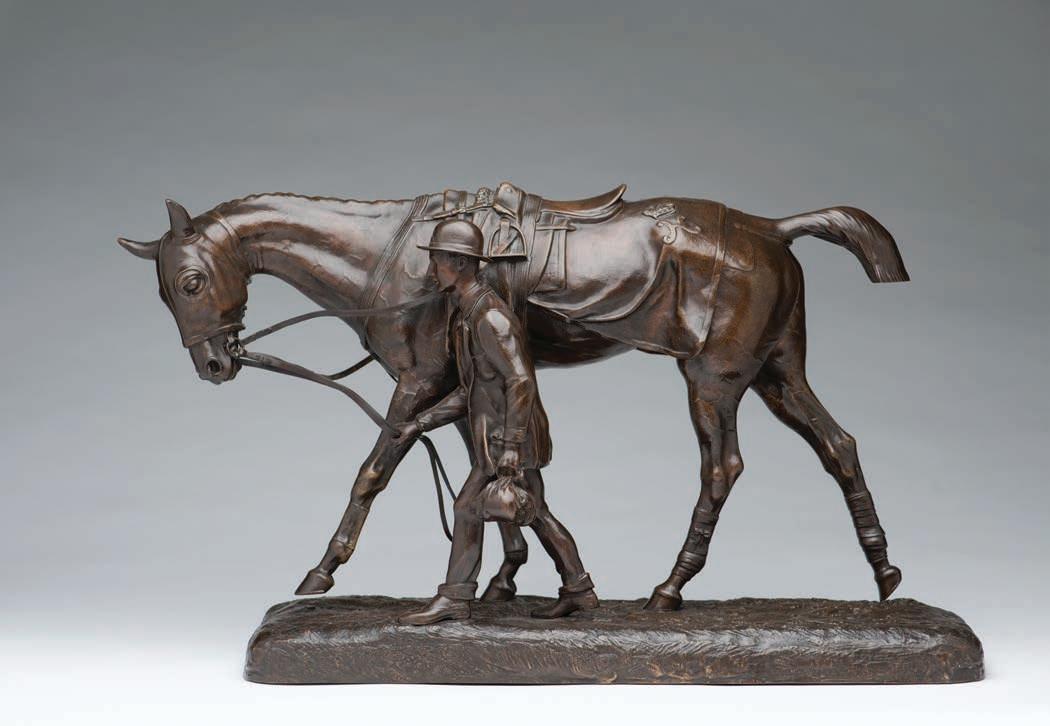
ARTHUR-MARIE-GABRIEL, COMTE DU PASSAGE (French, 1838-1909)
Racehorse and Groom, 1885
Signed, dated 1885 and inscribed Boudet E dt 43 Bld des Capucines
Bronze; rich dark brown patina, 13 1/2 x 24 x 7 1/2 inches
30.
SIR ALFRED JAMES MUNNINGS, PRA
Helter Skelter
Provenance:
Acquired from the artist and by descent in a British Private Collection
Sale Bonhams, London, 20th Century British Art, July 11, 2006, lot #10
Richard Green Gallery, London, 2006
Private Collection, Britain
Red Fox Fine Art, Middleburg, Virginia
Private American Collection, 2016
Helter Skelter showcases Munnings’ vigilant eye for capturing equine expression and movement. It is a masterpiece of observation presenting a medley of ponies cresting a hill in a frenzy of excitement. The name of this work clearly describes the scene. Ponies are driven forward by Munnings’ groom, Shrimp who shouts and waves a stick. The anxious ponies, panic in their eyes, clump together to flee the commotion.
Like many artists, Munnings often painted a series of works with a common theme. For over a decade, he explored the subject of horses approaching the viewer in a three-quarter angle. Not only did this diagonal illustrate his faultless sense of perspective, it also tested his technical acumen of anatomy and understanding of the visual mechanics of equine motion. The earliest and largest picture from this series was The Vagabonds, painted in 1902, measuring 50 x 80 inches. In 1910
Exhibited:
London, Royal Institute of Painters in Watercolours, 1911. no. 362.
Middleburg, VA, National Sporting Library & Museum, 2013. no. 4.
Munnings painted another large oil, 30 x 43 inches, titled Coming Through the Gap, very close in many respects to the Helter Skelter watercolor of 1911. A comparison favors the watercolor which is bursting with color and energy.
The white pony that lights up the center of Helter Skelter is probably Augereau, which Munnings bought from the gypsy horse dealer Drake earlier in his career. The use of a white pony or horse to provide a visual focus is a favorite motif of the artist in this series. Although Munnings exhibits extraordinary skill in the medium of watercolor, Helter Skelter is a relatively rare work in his oeuvre as he gave up the medium in the mid-1920s.
We are grateful to Lorian Peralta-Ramos for kindly assisting in the cataloguing of this work, which will be included in her forthcoming catalog raisonné of Sir Alfred James Munnings, PRA.
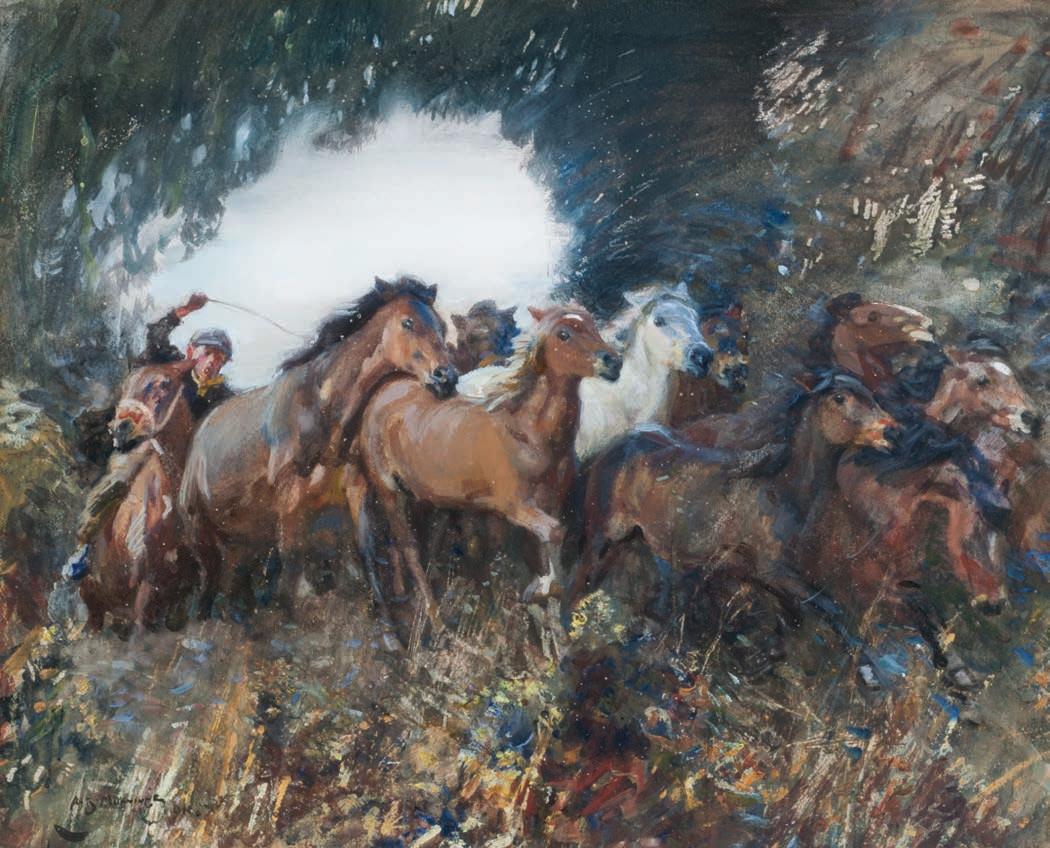
(British, 1878-1959)
Helter Skelter
Signed and dated 1911
Watercolor and gouache on paper, 16¾ x 20¾ inches
31.
SIR ALFRED JAMES MUNNINGS, PRA

1845-1879)
Huntsman Calling for Hounds and Whip Halloing, ‘Gone Away’
Both signed Silver plated bronze, 11 1/2 x 11 x 4 inches
32.
JOHN WILLIS GOOD (British,
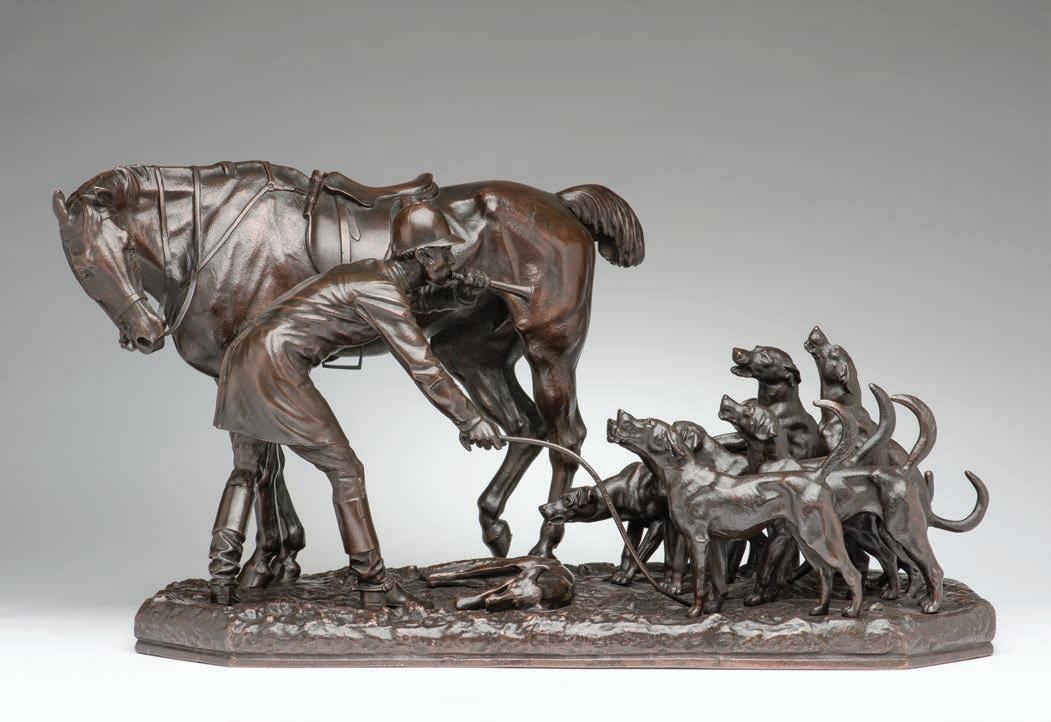
(British, 1845-1879)
Huntsman and Hounds at the End, 1872
Signed and dated 1872
Bronze; rich brown patina, 12 x 22 1/2 x 11¼ inches
33.
JOHN WILLIS GOOD
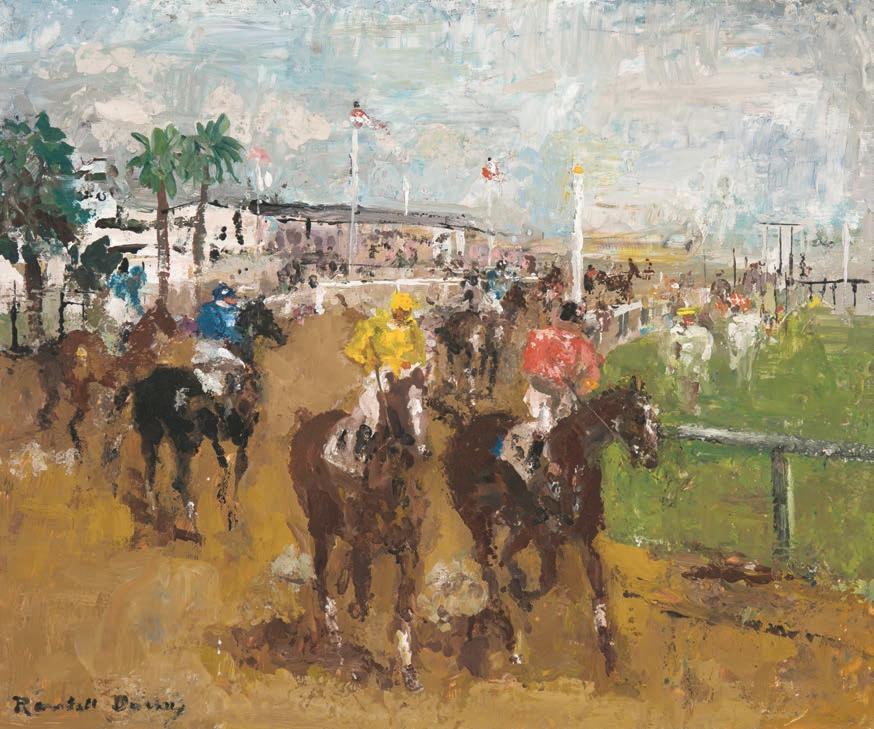
(American, 1887-1964)
At the Races
Signed Oil on masonite, 16 x 19¼ inches
34.
RANDALL VERNON DAVEY
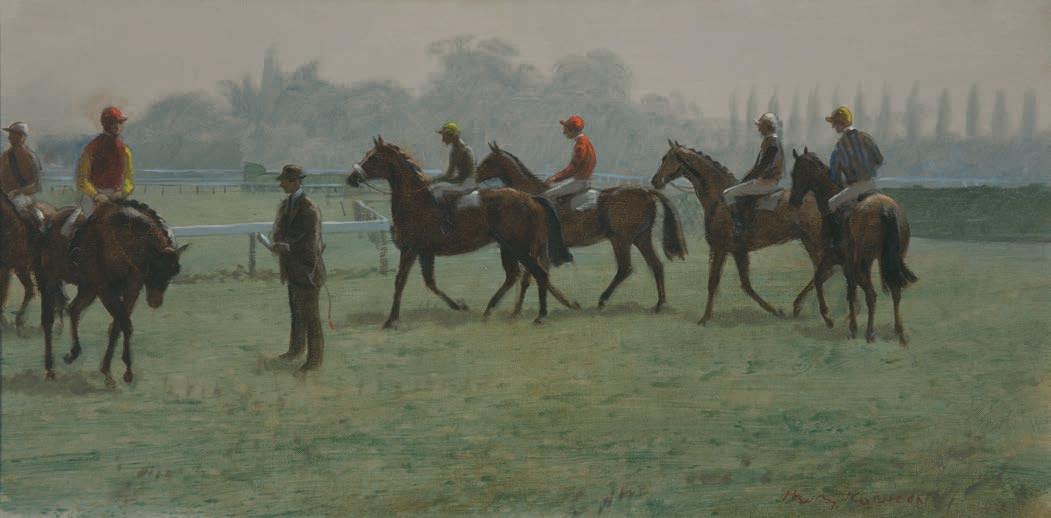
Signed, inscribed as titled and dated 1976 verso Oil on canvas, 12 x 24 inches
35.
HENRY KOEHLER (American, b. 1927)
Fontwell Starter
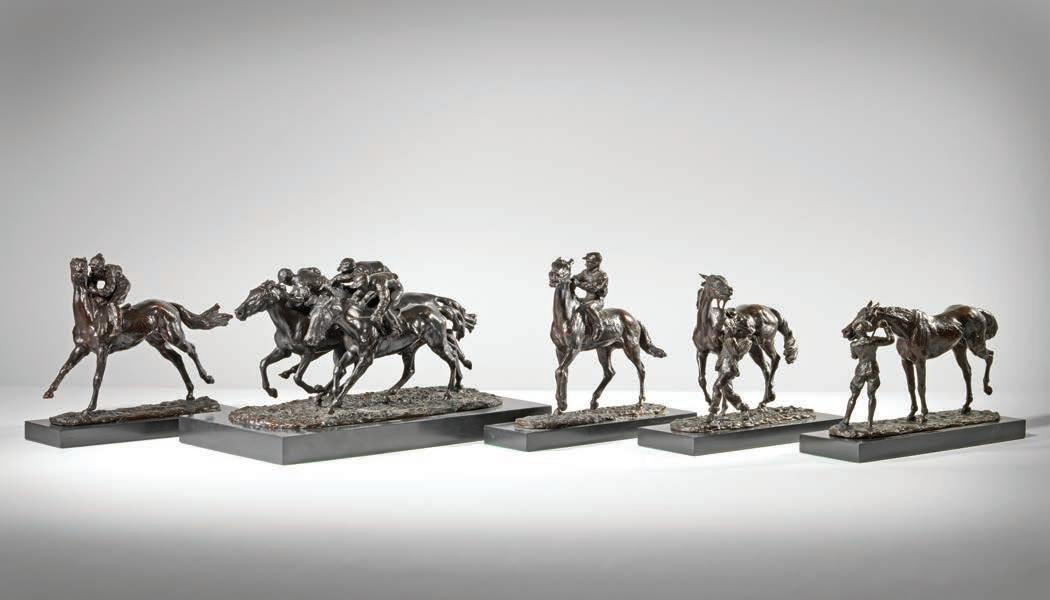
36.
RENÉ PARIS
(French, 1881-1970)
A Set of Five Racing Bronzes, c.1924
Each signed René Paris
Bronze; medium brown patina with dark brown undertones
Each titled in order from left to right as pictured above:
Two Years Old Canter (7 x10 inches), The Finish (6 x4 inches), The Start (7 x9 inches), Racehorse and Trainer (7 x8 inches), Racehorse and Groom (6 x10 inches)
Note:
Each bronze is afixed to a black marble base, ¾ inches thick, with lengths and widths varying from 9 to 3 inches.
Casting Note:
These bronzes were produced using the lost wax casting process prior to 1930.
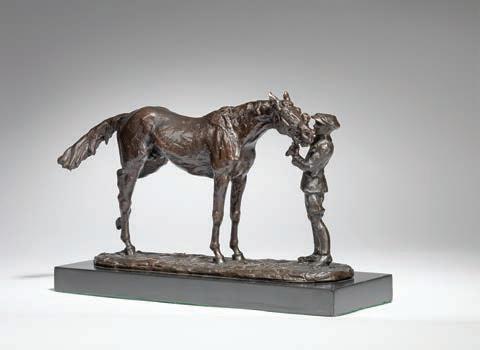
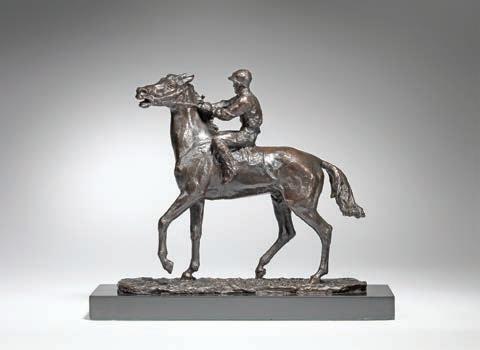
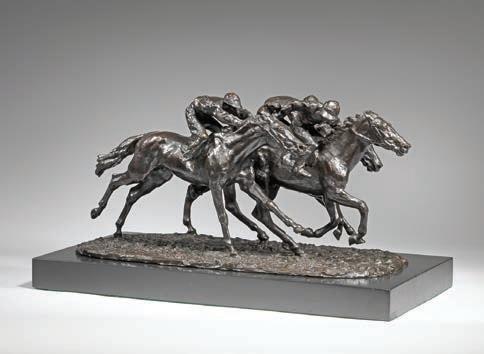
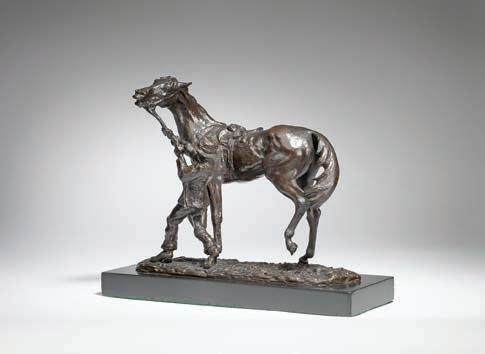
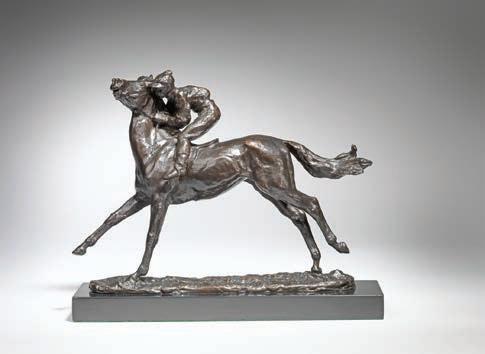
Racehorse and Groom
The Finish
Two Years Old Canter
Racehorse and Trainer
The Start
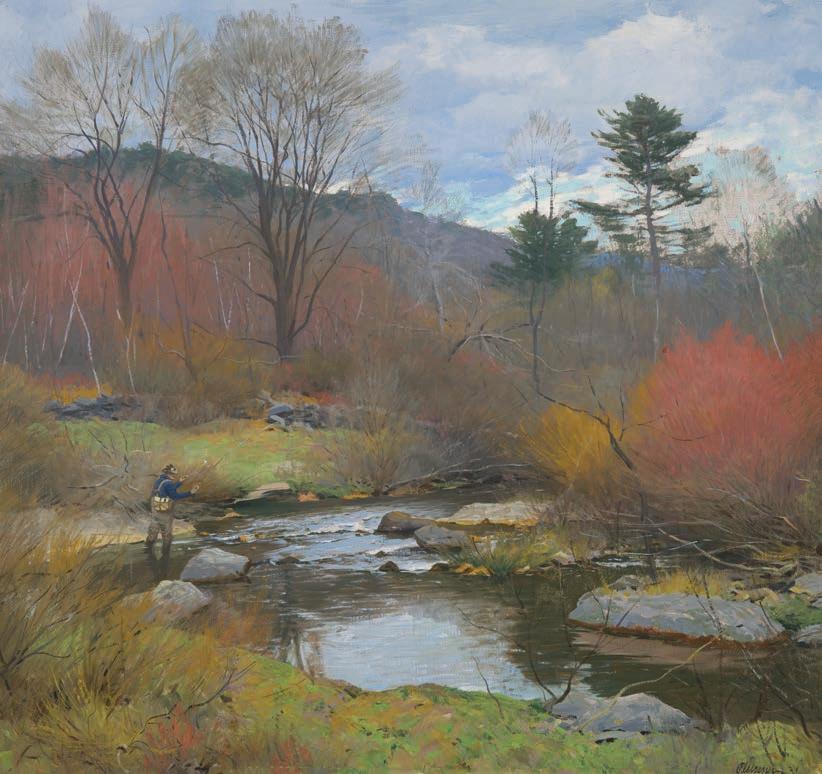
(American, 1905-1983)
Opening of Trout Season
Signed and dated 31 Oil on canvas, 28 1/2 x 30¼ inches
37. OGDEN M. PLEISSNER
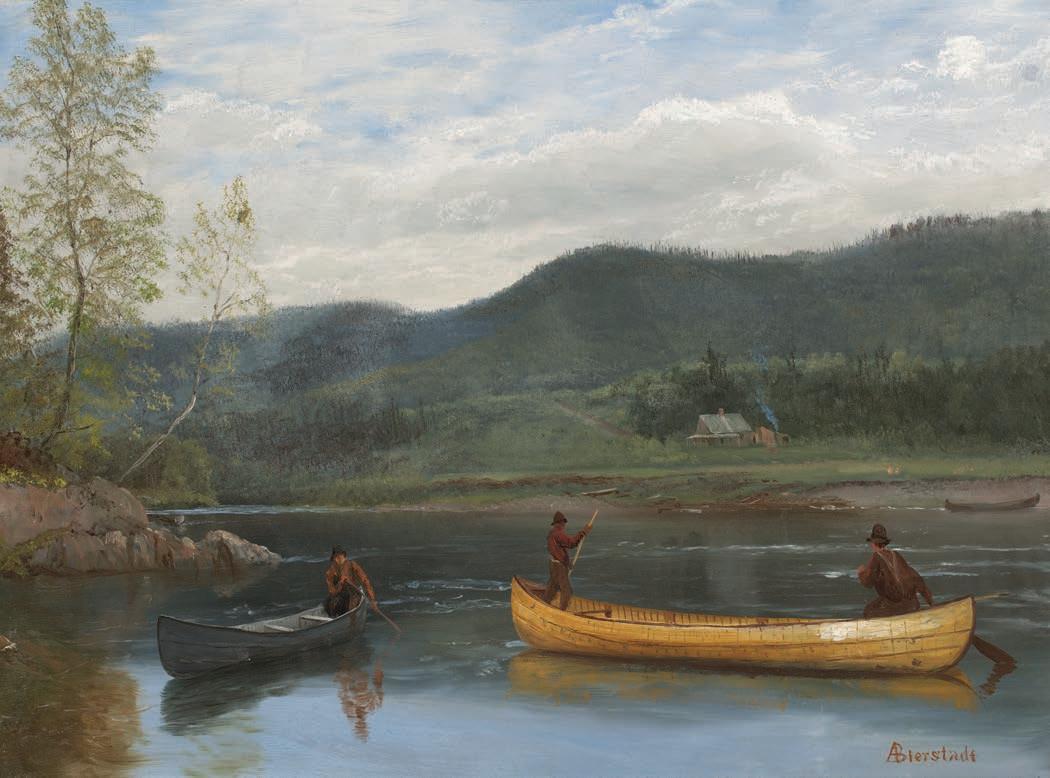
(American, 1830-1902)
Sportsmen in Canoes Signed Oil on paper laid down on panel, 14 x 193/8 inches
38.
ALBERT BIERSTADT
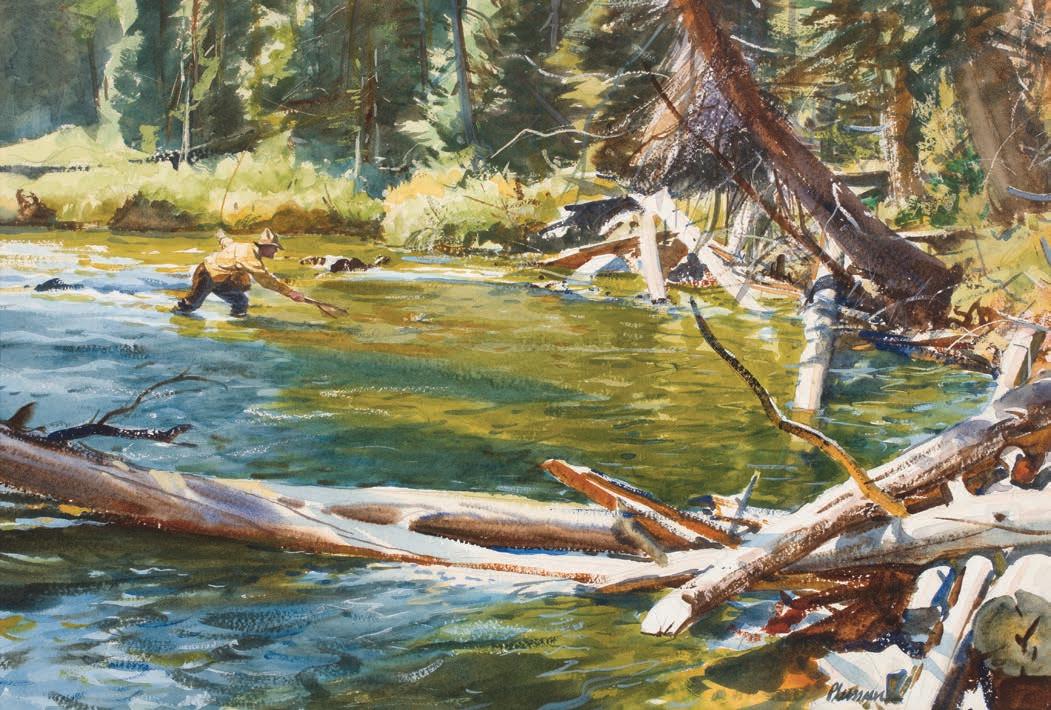
The Outlet Pool Signed Watercolor on paper, 141/2 x 211/2 inches
39.
OGDEN M. PLEISSNER (American, 1905-1983)
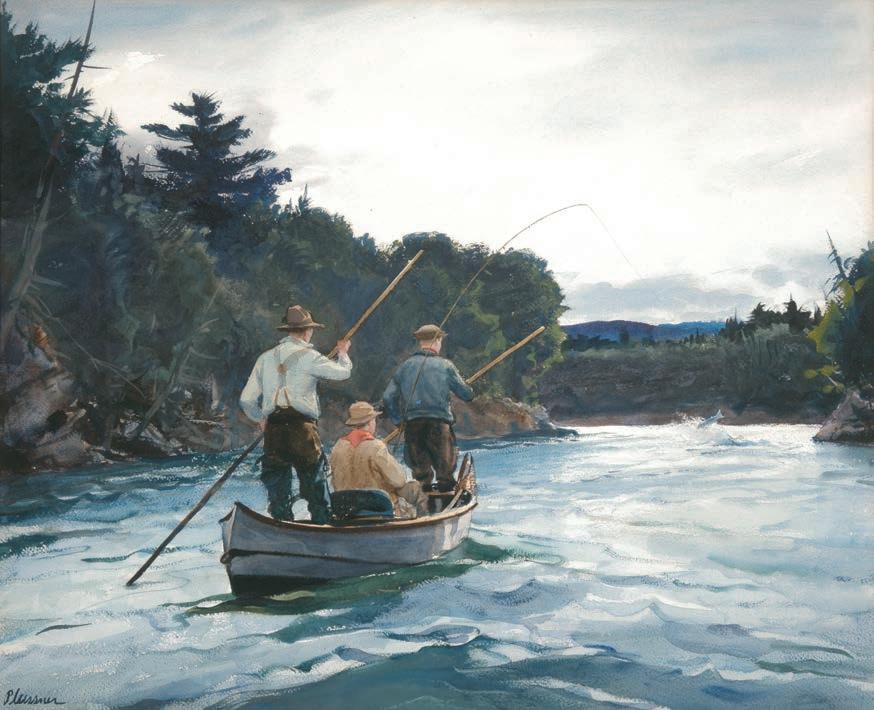
Salmon
Signed Watercolor on paper, 21¾ x 27 inches
40.
OGDEN M. PLEISSNER (American, 1905-1983)
Fishing
FRANK W. BENSON
Lower Camp Pool
Provenance:
Mr. Moreau Delano, West Orange, New Jersey
Susan A. Delano, McKelvey, (sister of the above) New York & Boston Massachusetts, 1937
By bequest from the above to the Museum of Fine Arts, Boston, 1964
Sale Christie’s, New York, Important American Paintings Drawings & Watercolors, May 18, 2004, lot #57
A Private American Collection until the present
In Lower Camp Pool, painted in 1928, Benson has retained the light palette and Impressionist style that received wide acclaim earlier in his career. An avid sportsman and outdoorsman Benson painted fishing and hunting subjects throughout his lifetime. He demonstrated a deep appreciation for the natural world while interpreting the light and colors of his rural surroundings with skill and perception on a par with the work of Winslow Homer a generation before him.
In 1895 the artist wrote to a friend “Salmon fishing seems to me the finest sport in the world” (F.A. Bedford, Frank W. Benson: American Impressionist, New York,1994, p.208) and in the late 1920s and early 1930s he frequented the salmon rivers of North America, creating an extraordinary group of oils and watercolors. “Some of Benson’s paintings of this period, especially his large oils, were often more landscape than figure study, more about nature than the people who inhabit it…the tiny man silhouetted against a patch of silver water is insignificant. His being is subordinated to the majesty of the looming mountain and the power of the swift stream.” (Frank W. Benson: American Impressionist, p. 200)
Benson builds the composition in Lower Camp Pool with large blocks of color in cool hues, emphasizing the calmness of nature while giving the effect of early morning light shimmering off the surface of the water. He concentrates his painting on the total mood of the work rather than the figures, placing the fishermen in an expansive landscape with imposing mountains and towering trees drenched in light and shadow. Faith Andrews Bedford writes that “Benson was never happier than when he was outdoors. He worked hard and long to support organizations that fostered stewardship of the land and conservation of its resources.” (Frank W. Benson: American Impressionist, p.200) Lower Camp Pool typifies Benson’s highly personal imagery, bringing together Impressionist technique and sporting art at its best.
The note above is drawn from Christie’s catalog entry of May 18, 2004. This work will be included in the forthcoming catalog raisonné being compiled by Vose Galleries of Boston.
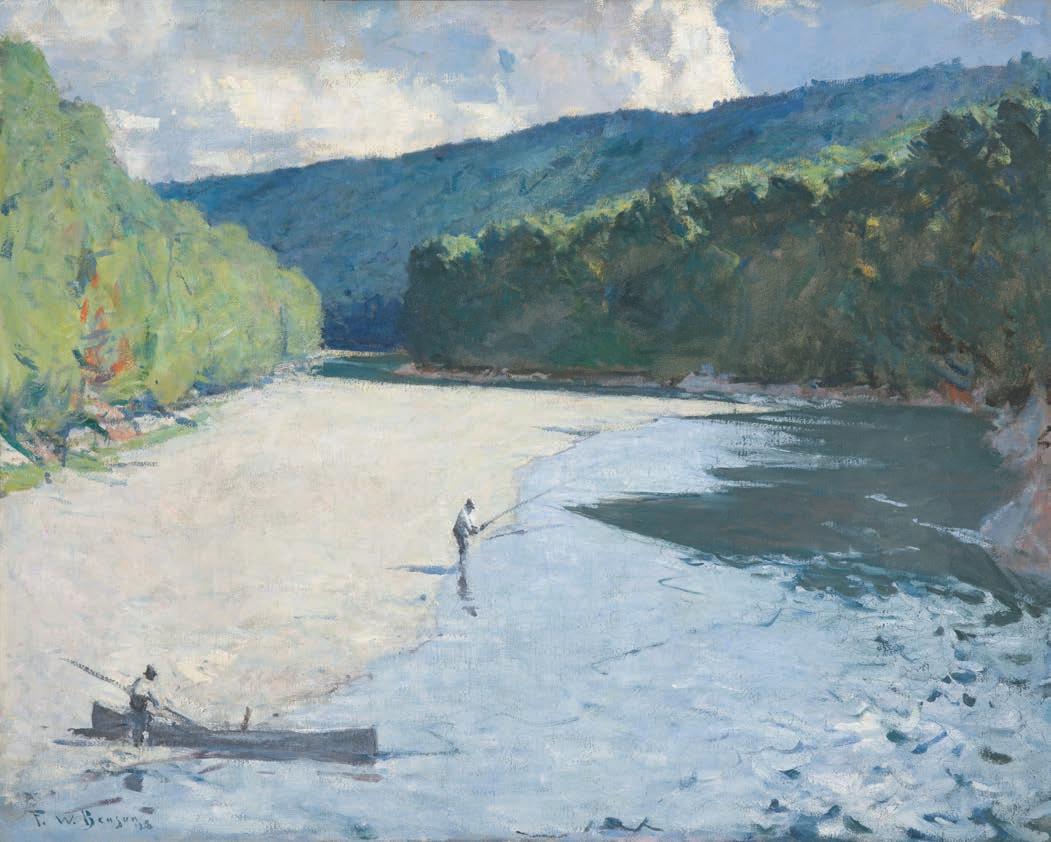
Signed and dated ‘28 Oil on canvas, 32 x 40 inches
41.
FRANK W. BENSON (American, 1862-1951)
Lower Camp Pool
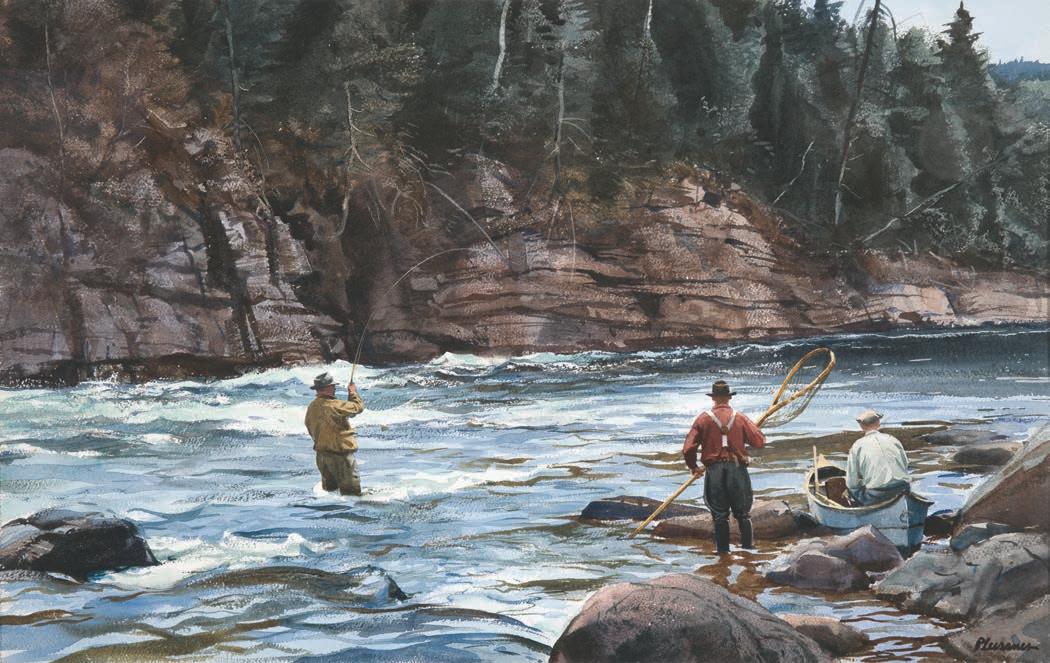
(American, 1905-1983) Heavy Water, St. John Signed Watercolor on paper, 19 x 30 inches
42.
OGDEN M. PLEISSNER
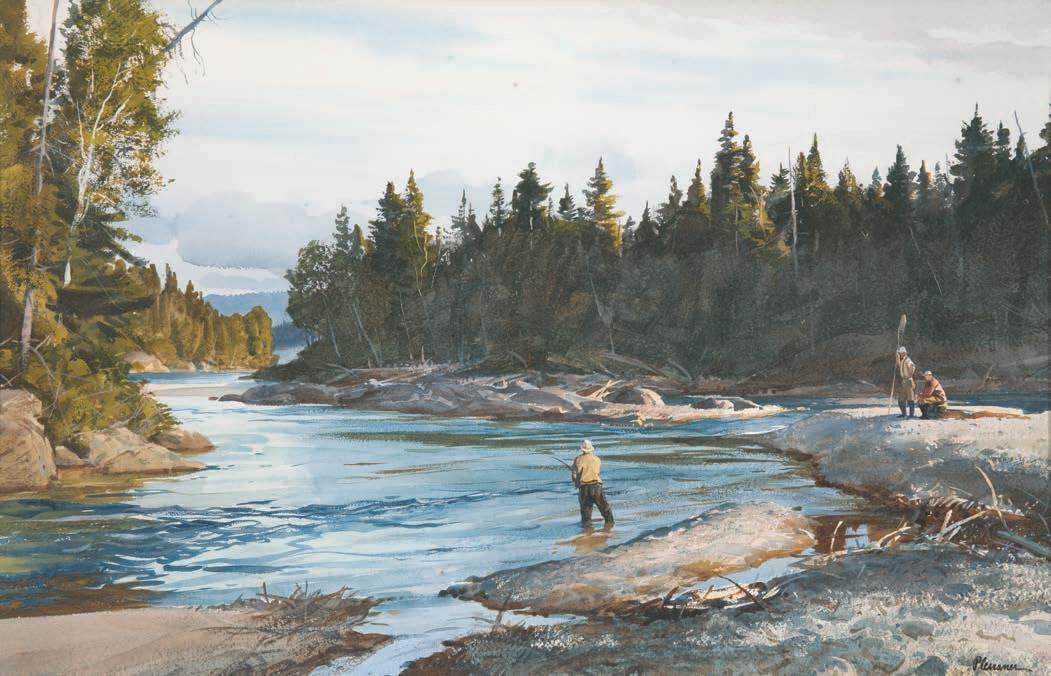
(American, 1905-1983) Fisherman on the George Pool Signed Watercolor on paper, 18 x 28 inches
43.
OGDEN M. PLEISSNER
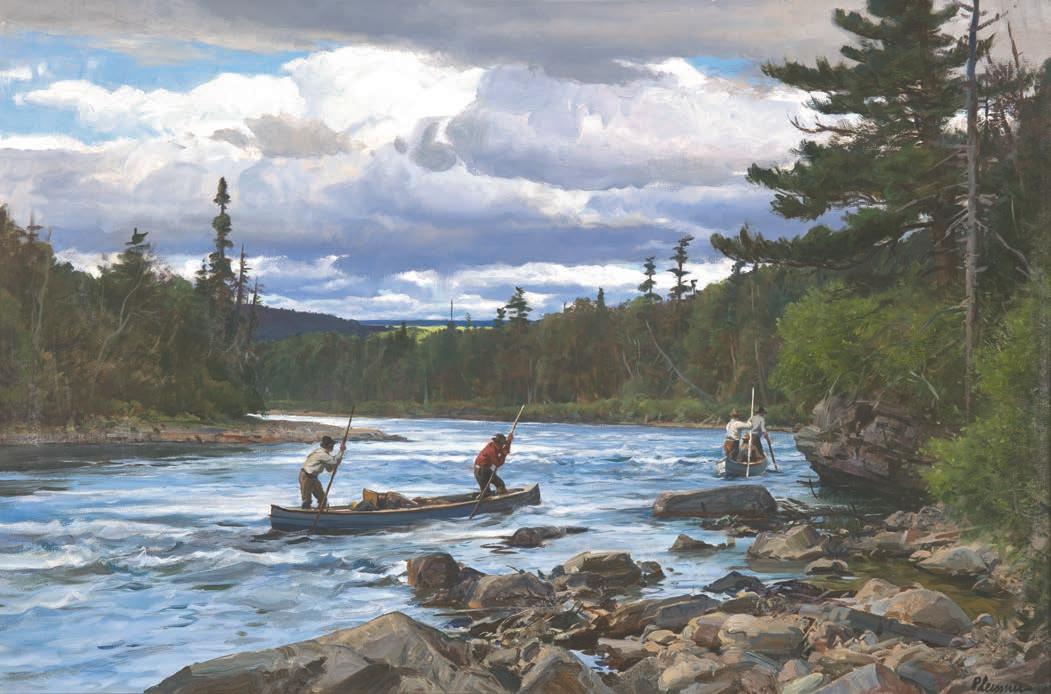
(American, 1905-1983)
Poling Up the York
Signed Oil on canvas, 24 x 36 inches
44.
OGDEN M. PLEISSNER
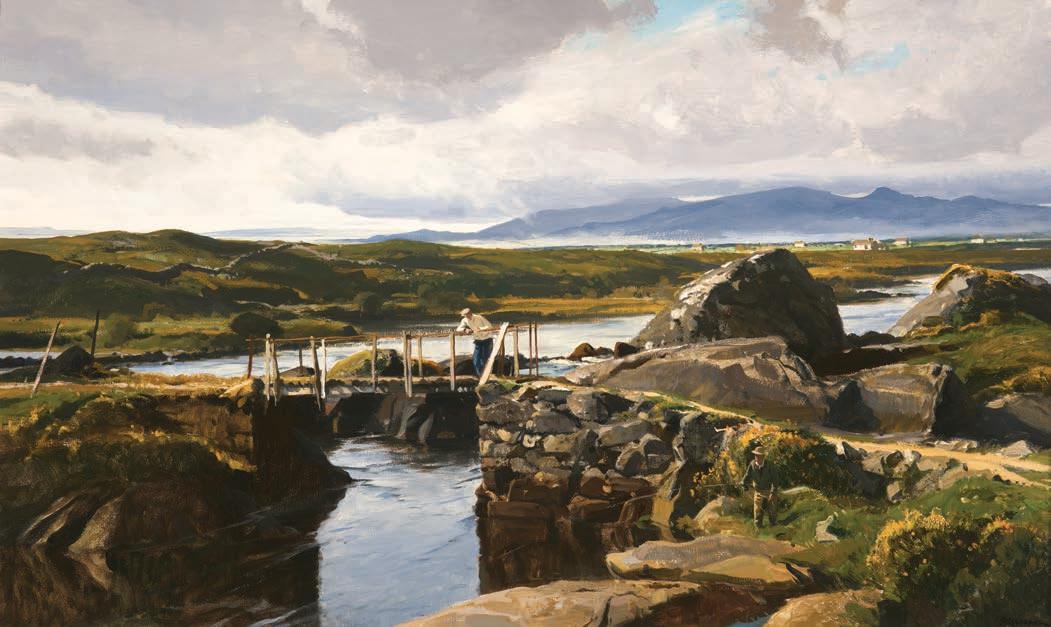
(American, 1905-1983)
The Bridge Pool, Ballynahinch Signed Oil on canvas, 24 x 40 inches
45.
OGDEN M. PLEISSNER
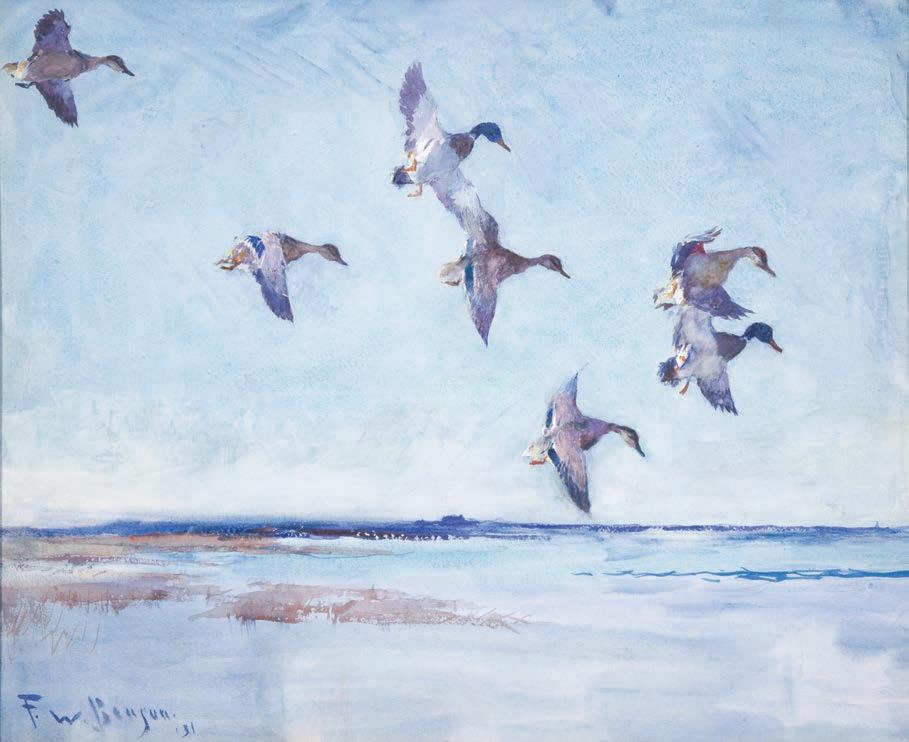
Ducks Coming In Signed and dated ‘31
Watercolor on paper, 20 x 24 inches
46.
FRANK W. BENSON (American, 1862-1951)
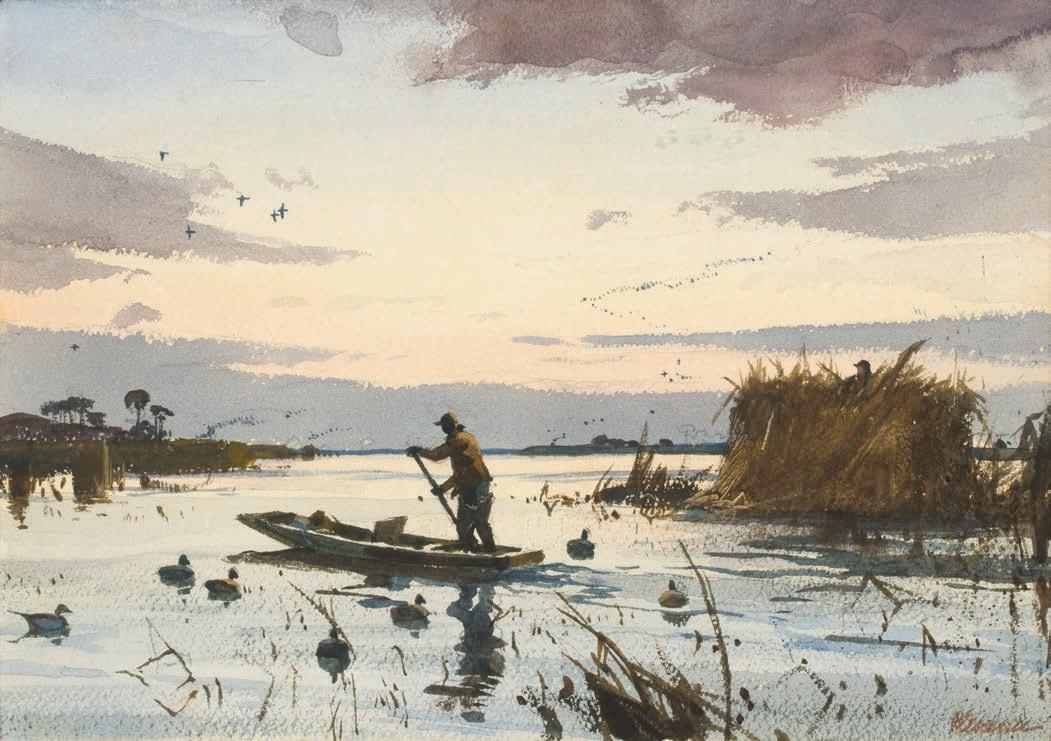
Signed
Watercolor on paper, 7 x 10 inches
47.
OGDEN M. PLEISSNER (American 1905-1983)
Carolina Marsh
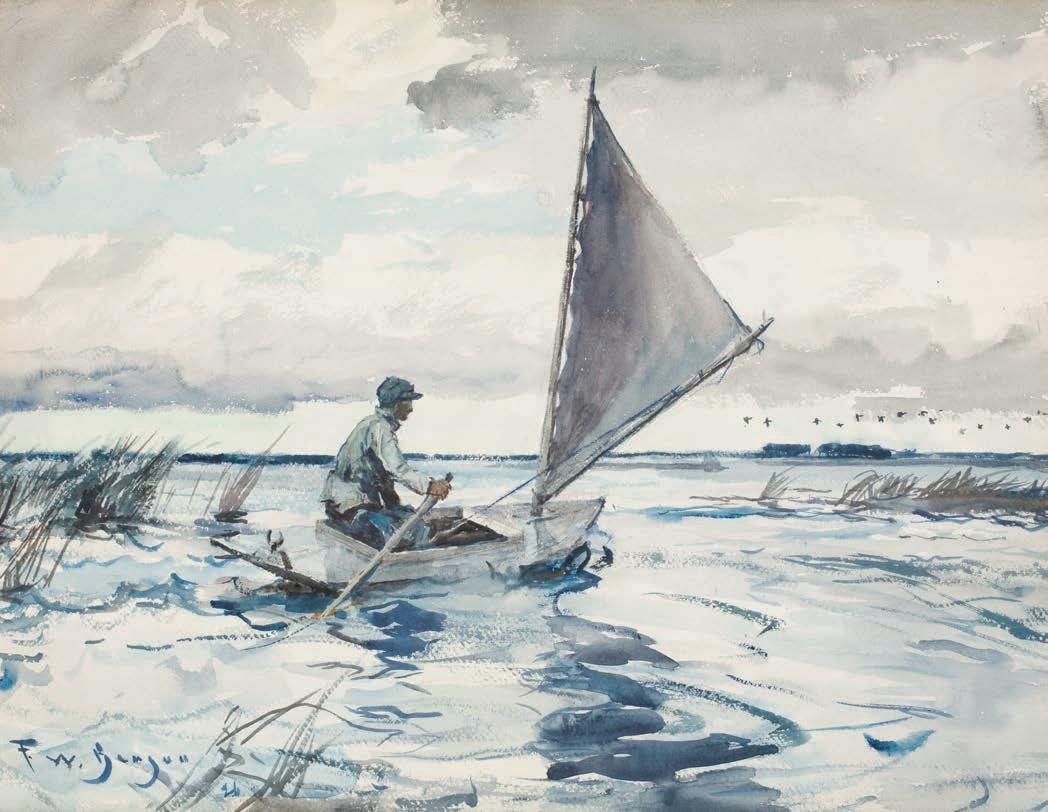
Setting Out
Signed and dated ‘26
Watercolor on paper, 18¾ x 24¾ inches
48.
FRANK W. BENSON
(American, 1862-1951)
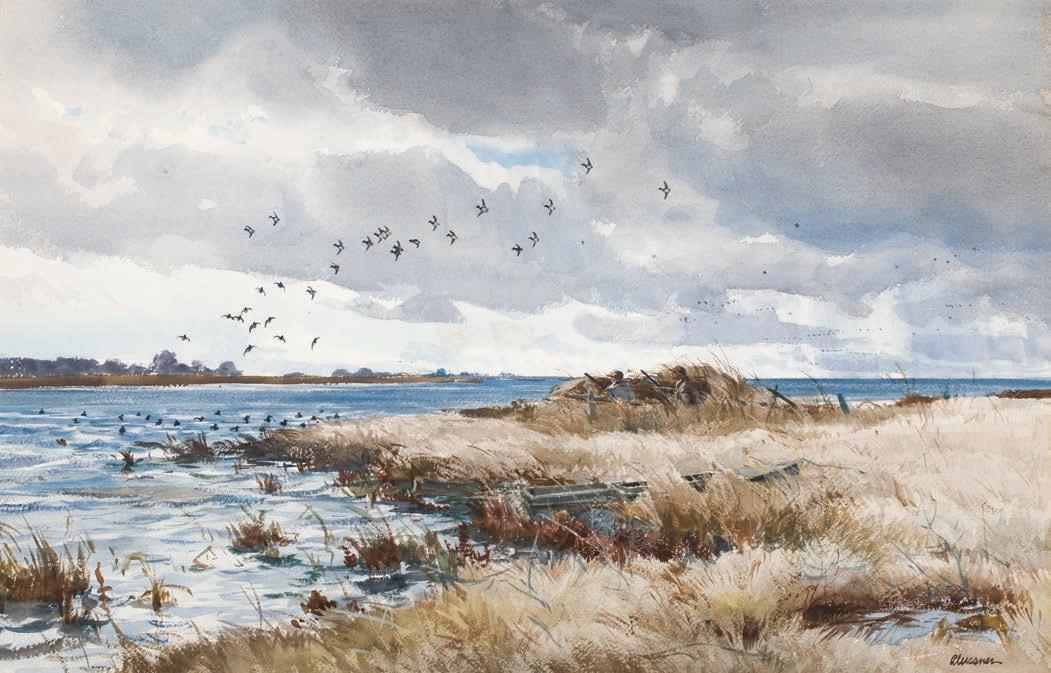
(American, 1905-1983)
Blue Bills Coming in to the Decoys Signed Watercolor on paper, 16 x 25 inches
49.
OGDEN M. PLEISSNER
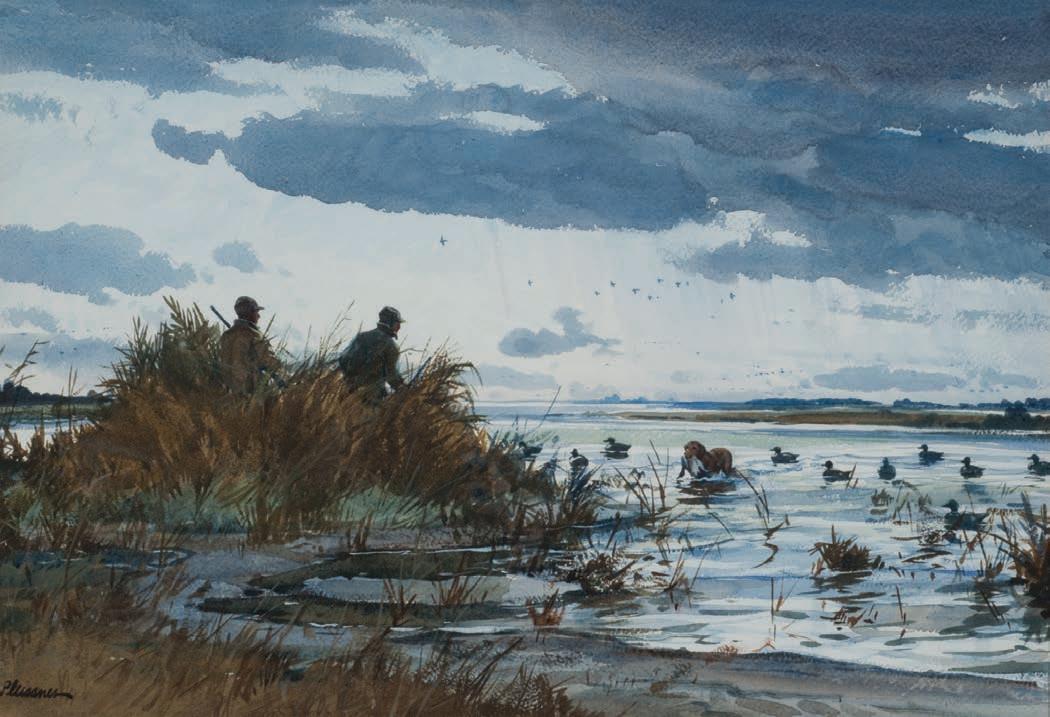
1905-1983)
Duck Shooting Over Decoys Signed Watercolor on paper, 14 1/2 x 21 1/2 inches
50.
OGDEN M. PLEISSNER (American,
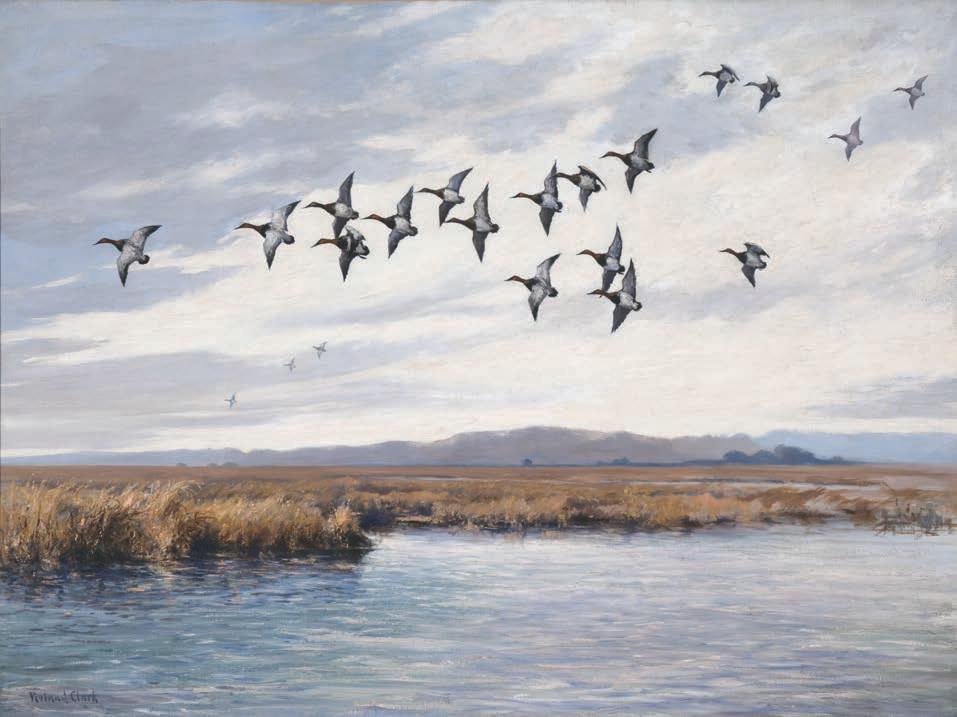
Canvasbacks in Flight Signed Oil on canvas, 36 x 48¼ inches
51.
ROLAND CLARK (American, 1874-1957)
MONTAGUE DAWSON
The Great Race - Ariel & Taeping
Provenance:
Frost & Reed, London, September 4, 1967
Acquired from the above and by descent until the present
Tea was one of the very few commodities carried at speed in the heyday of sail. Other cargoes were either too bulky or insufficiently valuable to make it worth risking a whole ship and crew while racing through the typhoons and the shoals of the South China Sea with all sails set, just to be able to dock in the Port of London a few hours or days ahead of the pack. But in the middle of the 19th century, demand for fresh tea was such that the first vessel home from Fuzhou or Shanghai could command a premium of at least 10 percent for her wares.
The flourishing of the China trade crowned centuries of trial and error with masts and sail. The power that a clipper could draw from a following wind with all sails set was far greater than anything that could be supplied from contemporary steam engines. A typical clipper ship of the late 1860s had three masts, each of which would be fitted (looking from the bottom up) with a lower course sail, double topsails, single or double topgallants, a royal and a skysail. Some captains, anxious to cram on every stitch of canvas, might also unfurl small sails known as moonrakers at the very tip of each mast, and add supplementary staysails and studding sails, as well as fancy racing canvas
such as water sails close down along the waterline. A crack ship such as Ariel could easily set thirty or more sails in the most favorable conditions (some 25,000 feet of sailcloth), and any clipper taking part in the tea race might average 11 or 12 knots in reasonable conditions, at a time when the steam fleet made eight or nine knots and would need to stop for coal four or five times on a passage between Britain and China.
The Great Tea Race of 1866 caused an enormous stir in the sporting and nautical circles of Britain and China. Every man with a nautical cut to his jib had bet upon the result while the rival owners, agents and shippers wagered huge sums. Ariel and Taeping had left Fuzho, China on the same tide, sailed over 14,000 miles in a race lasting 99 days, then docked in London on the same tide, with less than thirty minutes between them. Taeping docked 28 minutes before Ariel.
This note is drawn in large part from the article The Great Tea Race of 1866 written by Mike Dash for the Smithsonian Magazine, December 15, 2011.
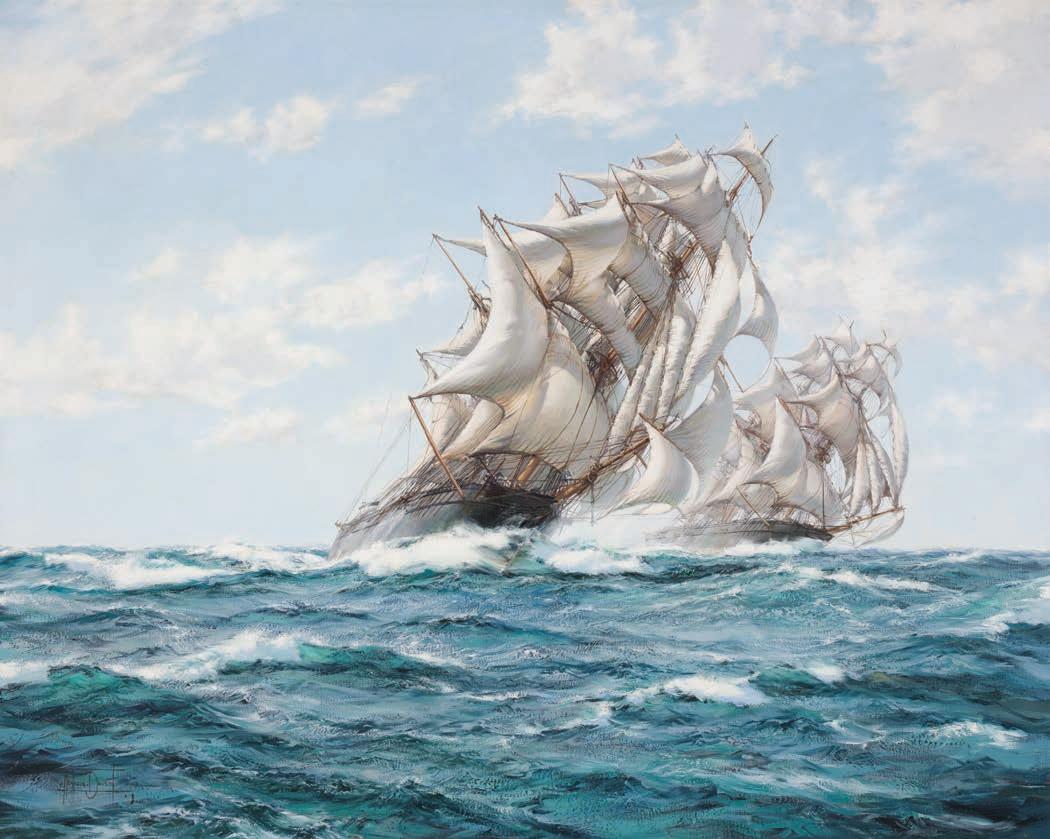
(British, 1890-1973)
The Great Race - Ariel & Taeping Signed Oil on canvas, 40 x 50 inches
52.
MONTAGUE DAWSON
SIR ALFRED JAMES MUNNINGS, PRA
Withypool Landscape, Exmoor
Provenance:
Ian MacNicol, Glasgow
from whom acquired by E. Franklin Robbins in October 1968
Williams & Co., London, by 1999
Nicholas Boler, Esq., England
Sale Christie’s, New York Sporting Art, December 5, 2003, lot #120
Private Collection, Washington, D.C. to 2012, acquired at the above sale
Red Fox Fine Art, Middleburg, VA
Private Collection Charleston, SC, acquired from above 2013
While living on Exmoor during World War II, Munnings was inspired to capture the local landscape under the ever changing light conditions. He studied cloud formations and their light and shadowy effects on the landscape below. In his autobiography he writes of the inspiration that the Exmoor landscape provided, ‘Strong scents of phlox grown in masses of pink and white come through doors and windows. Such a breezy, bright morning, with clouds sailing over Withypool Hill opposite, is fatal to me,
for I must be off on a horse. There are no flies on days like this. Am I losing hold on Suffolk and Norfolk? Is this wild country casting its net over me? Exmoor, with its storms of ‘untimely violence’ and its gales of wind and rain, can change its face and smile, resuming ‘God’s gentle, sleeping peace,’ so that in the end everybody would stay if they could, or come again as they do.’ (Sir A.J. Munnings, An Artist’s Life, Bungay, 1950, p. 87)

(British, 1878-1959)
Withypool Landscape, Exmoor
Signed, painted circa 1940-44
Oil on panel, 20 x 24 inches
53.
SIR ALFRED JAMES MUNNINGS, PRA

A Sportsman and Setter: The Shooting Pictures Portfolio Frontispiece Illustration Signed Pen and ink on paper, 14 x 18 inches
54.
ARTHUR BURDETT FROST
(American, 1851-1928)
Index
Alken, Henry
The Epsom Derby, 1880, “Bend Or” with Fred Archer up Beating “Robert the Devil” with Rossiter up (Plate 28)
Benson, Frank W. Lower Camp Pool (Plate 41) Ducks Coming In (Plate 46) Setting Out (Plate 48)
Bierstadt, Albert Sportsmen in Canoes (Plate 38)
Browne, George Quail in the Pine Lands, 1956 (Plate 23)
Bonheur, Isidore Jules Retour au Pesage (Plate 29)
Caillebotte, Gustave Trois Perdrix sur une Table (Plate 12)
Clark, Roland Canvasbacks in Flight (Plate 51)
Dawson, Montague
The Great Race - Ariel & Taeping (Plate 52)
Davey, Randall Vernon At the Races (Plate 34)
Degas, Edgar Cheval faisant une descente de main, 1865-1881 (Plate 26)
Frost, Arthur Burdett Still Life of Hanging Ducks (Plate 11) Good Shot and Good Dog (Plate 13) A Sportsman and Setter: The Shooting Pictures Portfolio Frontispiece Illustration (Plate 54)
Good, John Willis Huntsman Calling for Hounds and Whip Halloing, ‘Gone Away’ (Plate 32) Huntsman and Hounds at the End, 1872 (Plate 33)
Haseltine, Herbert Suffolk Punch, 1929 (Plate 1)
Koehler, Henry Fontwell Starter (Plate 35)
Marshall, Benjamin Zinganee, Held by Sam Chifney, Jr. Wearing Lord Chesterfield’s Colors After Winning the Oatlands Stakes, Newmarket, circa 1829 (Plate 27)
Munnings, Sir Alfred James, PRA Under Starter’s Orders, Newmarket (Plate 25)
Helter Skelter (Plate 31)
Withypool Landscape, Exmoor (Plate 53)
Muss-Arnolt, Gustave Pointers in a Landscape (Plate 20)
Osthaus, Edmund Henry
A Setter Retrieving a Quail (Plate 14)
Paris, René
A Set of Five Racing Bronzes, c. 1924 (Plate 36)
Passage, Arthur-Marie-Gabriel, Comte du Racehorse and Groom, 1885 (Plate 30)
Pautrot, Ferdinand
Gun Dogs and Game, a pair (Plate 22)
Pleissner, Ogden M. Grouse Shooting (Plate 2)
Edge of the Cotton Field, Quail Shooting (Plate 3)
The Covey Rise (Plate 4)
Driven Grouse, Perthshire (Plate 6)
A High Shot, Perthshire (Plate 7)
Opening of Trout Season (Plate 37)
The Outlet Pool (Plate 39)
Salmon Fishing (Plate 40)
Heavy Water, St. John (Plate 42)
Fisherman on the George Pool (Plate 43)
Poling Up the York (Plate 44)
The Bridge Pool, Ballynahinch (Plate 45)
Carolina Marsh (Plate 47)
Blue Bills Coming in to the Decoys (Plate 49)
Duck Shooting Over Decoys (Plate 50)
Ripley, Aiden Lassel
Late Season Quail Shooting (Plate 15)
Covey Rise (Plate 16)
Rosseau, Percival Leonard
A Brace on Point (Plate 17)
Setters in a Landscape (Plate 18)
Setters on Birds (Plate 21)
Morning: Setters on Point (Plate 24)
Tait, Arthur Fitzwilliam
Quail and Young (Plate 19)
Tracy, John Martin
In the Grouse Woods (Plate 9)
In Quail Country (Plate 10)
Wardle, Arthur
Setters on the Moor (Plate 8)
Wright, George
On the Moor – Walking up (Plate 5)
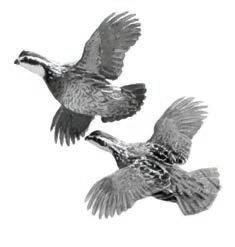
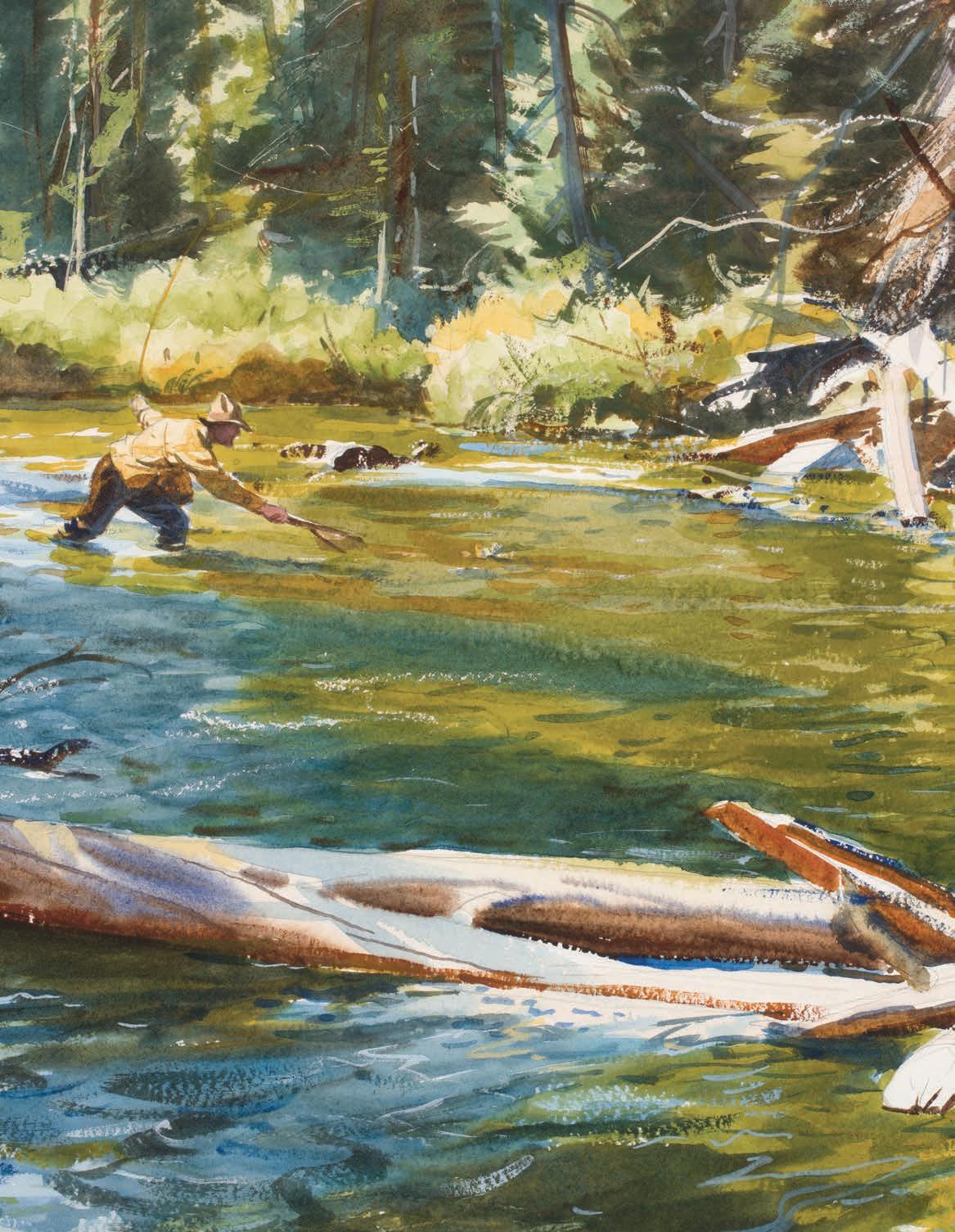
Opposite: OGDEN M. PLEISSNER, (detail) Plate 39
